Mass Migration to the United States: Challenges and Consequences
VerifiedAdded on 2023/03/23
|23
|6771
|43
AI Summary
This article discusses the challenges and consequences of mass migration to the United States. It explores the integration of migrants, changes in migration flows, and the impact on the ethnic composition of the country. It also examines the lack of federal policy for immigrant integration and the rise of migrant-phobia. Additionally, it delves into the reasons for migration in the region and the implications for social development.
Contribute Materials
Your contribution can guide someone’s learning journey. Share your
documents today.
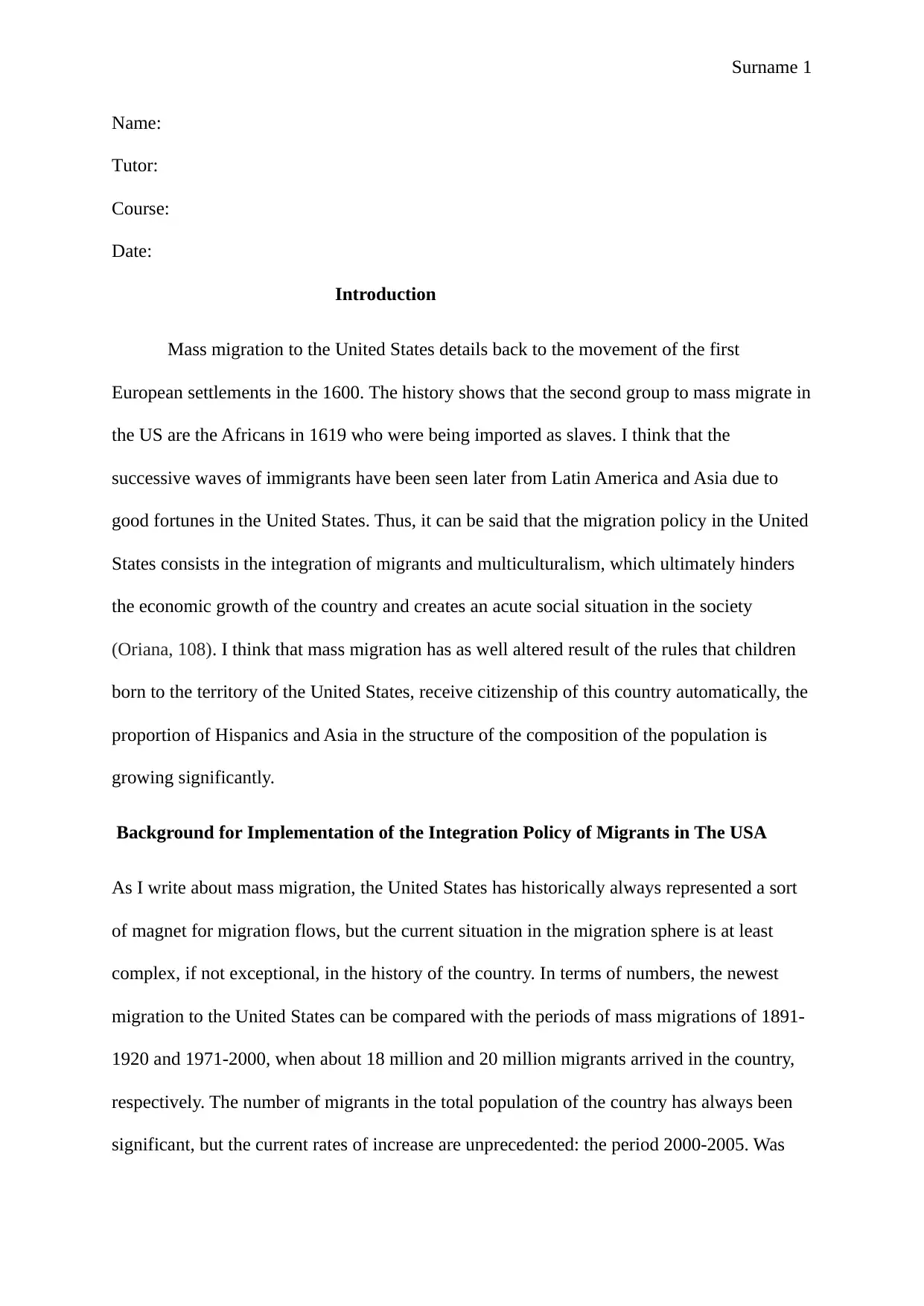
Surname 1
Name:
Tutor:
Course:
Date:
Introduction
Mass migration to the United States details back to the movement of the first
European settlements in the 1600. The history shows that the second group to mass migrate in
the US are the Africans in 1619 who were being imported as slaves. I think that the
successive waves of immigrants have been seen later from Latin America and Asia due to
good fortunes in the United States. Thus, it can be said that the migration policy in the United
States consists in the integration of migrants and multiculturalism, which ultimately hinders
the economic growth of the country and creates an acute social situation in the society
(Oriana, 108). I think that mass migration has as well altered result of the rules that children
born to the territory of the United States, receive citizenship of this country automatically, the
proportion of Hispanics and Asia in the structure of the composition of the population is
growing significantly.
Background for Implementation of the Integration Policy of Migrants in The USA
As I write about mass migration, the United States has historically always represented a sort
of magnet for migration flows, but the current situation in the migration sphere is at least
complex, if not exceptional, in the history of the country. In terms of numbers, the newest
migration to the United States can be compared with the periods of mass migrations of 1891-
1920 and 1971-2000, when about 18 million and 20 million migrants arrived in the country,
respectively. The number of migrants in the total population of the country has always been
significant, but the current rates of increase are unprecedented: the period 2000-2005. Was
Name:
Tutor:
Course:
Date:
Introduction
Mass migration to the United States details back to the movement of the first
European settlements in the 1600. The history shows that the second group to mass migrate in
the US are the Africans in 1619 who were being imported as slaves. I think that the
successive waves of immigrants have been seen later from Latin America and Asia due to
good fortunes in the United States. Thus, it can be said that the migration policy in the United
States consists in the integration of migrants and multiculturalism, which ultimately hinders
the economic growth of the country and creates an acute social situation in the society
(Oriana, 108). I think that mass migration has as well altered result of the rules that children
born to the territory of the United States, receive citizenship of this country automatically, the
proportion of Hispanics and Asia in the structure of the composition of the population is
growing significantly.
Background for Implementation of the Integration Policy of Migrants in The USA
As I write about mass migration, the United States has historically always represented a sort
of magnet for migration flows, but the current situation in the migration sphere is at least
complex, if not exceptional, in the history of the country. In terms of numbers, the newest
migration to the United States can be compared with the periods of mass migrations of 1891-
1920 and 1971-2000, when about 18 million and 20 million migrants arrived in the country,
respectively. The number of migrants in the total population of the country has always been
significant, but the current rates of increase are unprecedented: the period 2000-2005. Was
Secure Best Marks with AI Grader
Need help grading? Try our AI Grader for instant feedback on your assignments.
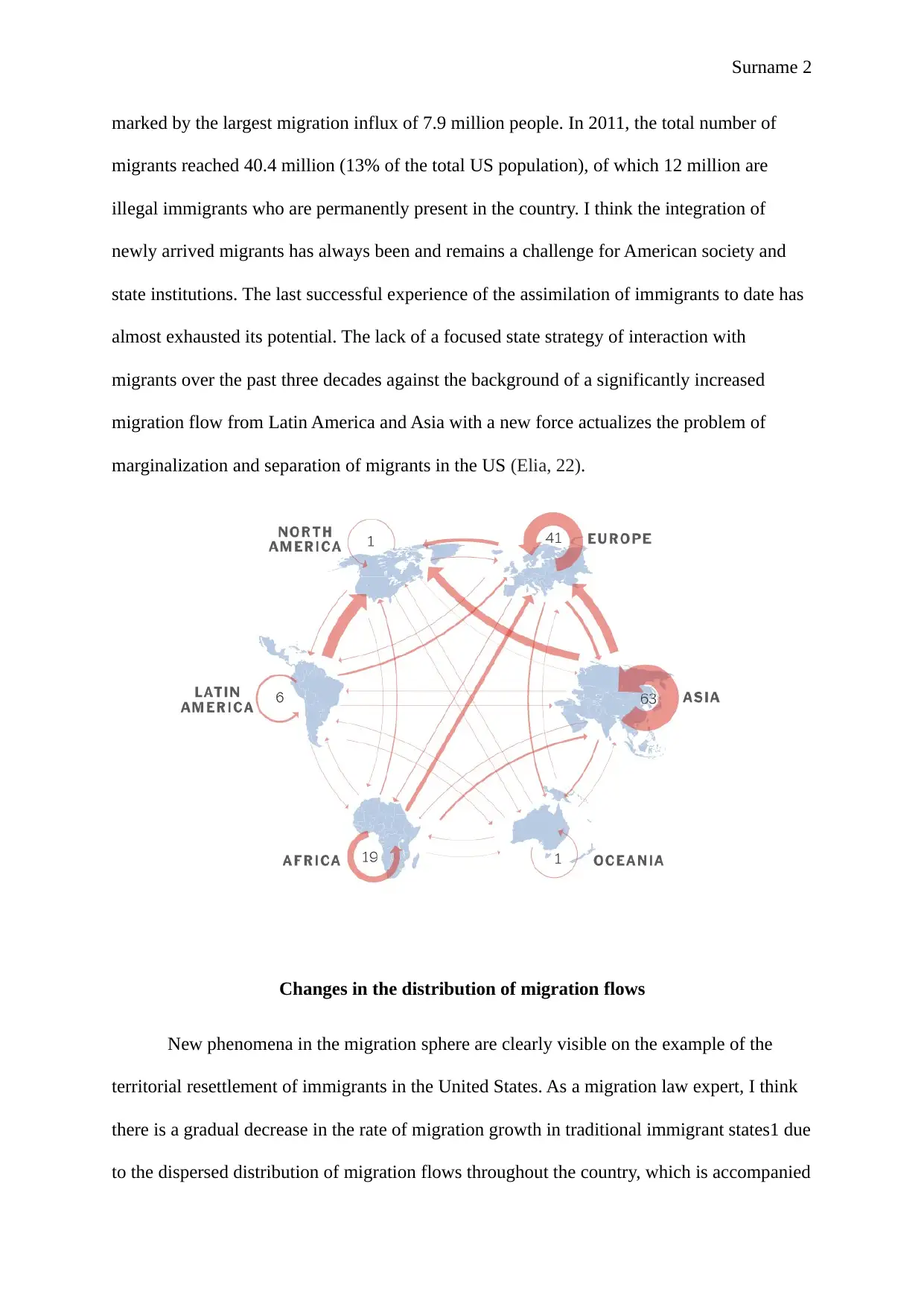
Surname 2
marked by the largest migration influx of 7.9 million people. In 2011, the total number of
migrants reached 40.4 million (13% of the total US population), of which 12 million are
illegal immigrants who are permanently present in the country. I think the integration of
newly arrived migrants has always been and remains a challenge for American society and
state institutions. The last successful experience of the assimilation of immigrants to date has
almost exhausted its potential. The lack of a focused state strategy of interaction with
migrants over the past three decades against the background of a significantly increased
migration flow from Latin America and Asia with a new force actualizes the problem of
marginalization and separation of migrants in the US (Elia, 22).
Changes in the distribution of migration flows
New phenomena in the migration sphere are clearly visible on the example of the
territorial resettlement of immigrants in the United States. As a migration law expert, I think
there is a gradual decrease in the rate of migration growth in traditional immigrant states1 due
to the dispersed distribution of migration flows throughout the country, which is accompanied
marked by the largest migration influx of 7.9 million people. In 2011, the total number of
migrants reached 40.4 million (13% of the total US population), of which 12 million are
illegal immigrants who are permanently present in the country. I think the integration of
newly arrived migrants has always been and remains a challenge for American society and
state institutions. The last successful experience of the assimilation of immigrants to date has
almost exhausted its potential. The lack of a focused state strategy of interaction with
migrants over the past three decades against the background of a significantly increased
migration flow from Latin America and Asia with a new force actualizes the problem of
marginalization and separation of migrants in the US (Elia, 22).
Changes in the distribution of migration flows
New phenomena in the migration sphere are clearly visible on the example of the
territorial resettlement of immigrants in the United States. As a migration law expert, I think
there is a gradual decrease in the rate of migration growth in traditional immigrant states1 due
to the dispersed distribution of migration flows throughout the country, which is accompanied

Surname 3
by the outflow of migrants from megalopolises. Thus, the demographer W. Frey, in his work
“The Myth of Diversity”, writes that newly arrived migrants come from Latin America and,
to a lesser extent, Asian countries, “live in regions where the majority of residents have never
heard Spanish or Chinese , - mainly in the suburbs, small towns and rural
settlements(Troy ,102). These new groups of migrants have practically replaced immigrants
from the countries of Southern and Eastern Europe. W. Frey notes that most of the US
population do not have the experience of living in a multiethnic multi-cultural environment,
and many representatives of the host society do not have the skills of intercultural
communication. In this regard, my thoughts are not only for immigrants, but also Native
Americans today have difficulties in adapting to a new multicultural reality.
1. Mass Hispanic migrants and their Influence
In the coming decades, I think serious qualitative changes are expected in the US
ethnic composition. First of all, they affect the dominant group of white Americans today: in
the period 1970–2050s. The number of white Americans is expected to decrease from 89% to
about 50% (or less than 50% if the pan-European decline in fertility prevails) due to mass
“foreign ethnic” migration and high birth rates in Spanish-speaking families, which is 48%
and 32% higher than white Americans and African Americans, respectively. I think it is
necessary to take into account that the uncertainty of the future of illegal migrants, mainly
Hispanic, makes it extremely difficult to predict the demographic situation and changes in the
ethnic composition of American society: according to the US Census Bureau, by 2050 the
population will increase to 439 million people; The UN predicts an increase to 402 million
(Massey, 89).
by the outflow of migrants from megalopolises. Thus, the demographer W. Frey, in his work
“The Myth of Diversity”, writes that newly arrived migrants come from Latin America and,
to a lesser extent, Asian countries, “live in regions where the majority of residents have never
heard Spanish or Chinese , - mainly in the suburbs, small towns and rural
settlements(Troy ,102). These new groups of migrants have practically replaced immigrants
from the countries of Southern and Eastern Europe. W. Frey notes that most of the US
population do not have the experience of living in a multiethnic multi-cultural environment,
and many representatives of the host society do not have the skills of intercultural
communication. In this regard, my thoughts are not only for immigrants, but also Native
Americans today have difficulties in adapting to a new multicultural reality.
1. Mass Hispanic migrants and their Influence
In the coming decades, I think serious qualitative changes are expected in the US
ethnic composition. First of all, they affect the dominant group of white Americans today: in
the period 1970–2050s. The number of white Americans is expected to decrease from 89% to
about 50% (or less than 50% if the pan-European decline in fertility prevails) due to mass
“foreign ethnic” migration and high birth rates in Spanish-speaking families, which is 48%
and 32% higher than white Americans and African Americans, respectively. I think it is
necessary to take into account that the uncertainty of the future of illegal migrants, mainly
Hispanic, makes it extremely difficult to predict the demographic situation and changes in the
ethnic composition of American society: according to the US Census Bureau, by 2050 the
population will increase to 439 million people; The UN predicts an increase to 402 million
(Massey, 89).
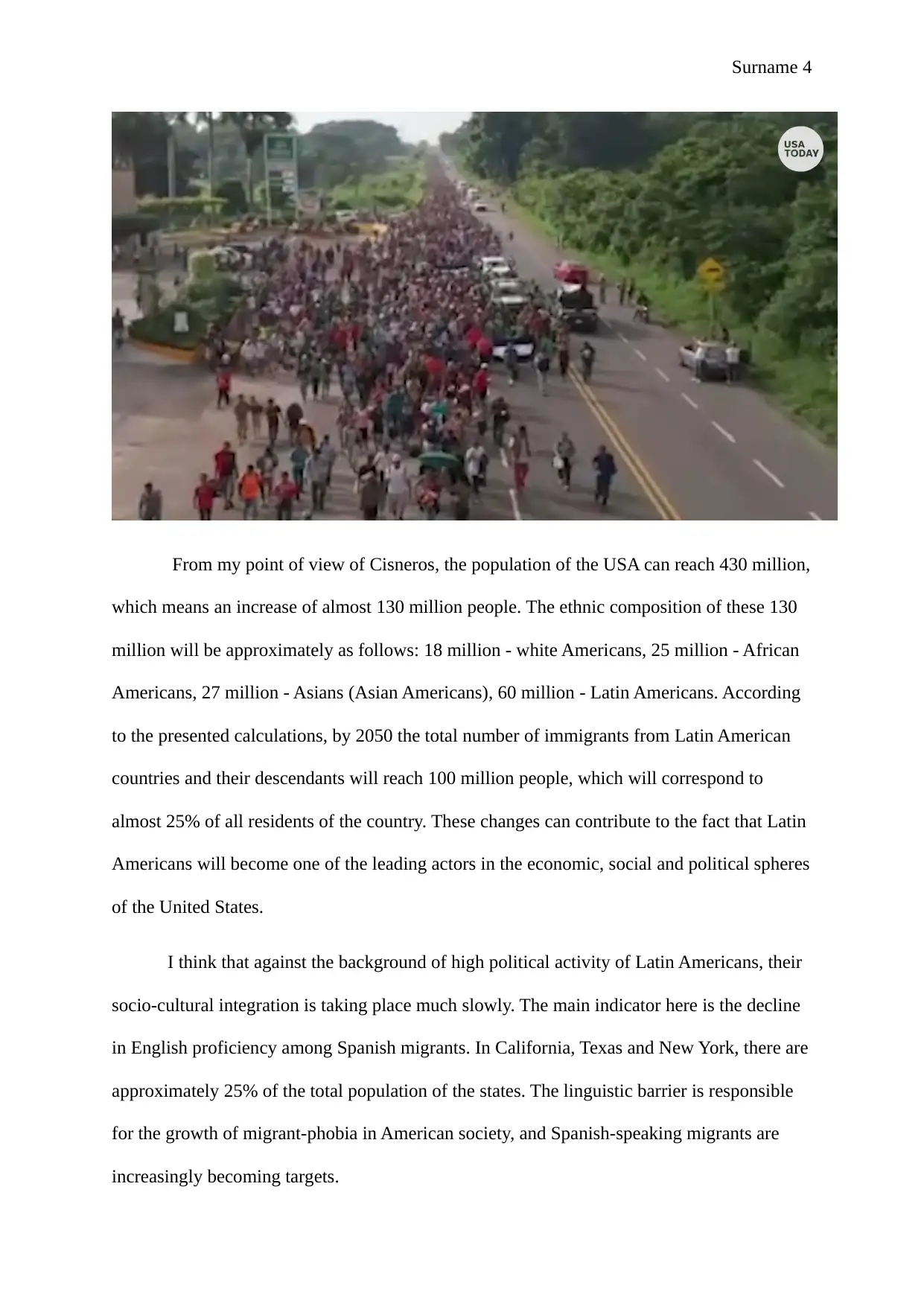
Surname 4
From my point of view of Cisneros, the population of the USA can reach 430 million,
which means an increase of almost 130 million people. The ethnic composition of these 130
million will be approximately as follows: 18 million - white Americans, 25 million - African
Americans, 27 million - Asians (Asian Americans), 60 million - Latin Americans. According
to the presented calculations, by 2050 the total number of immigrants from Latin American
countries and their descendants will reach 100 million people, which will correspond to
almost 25% of all residents of the country. These changes can contribute to the fact that Latin
Americans will become one of the leading actors in the economic, social and political spheres
of the United States.
I think that against the background of high political activity of Latin Americans, their
socio-cultural integration is taking place much slowly. The main indicator here is the decline
in English proficiency among Spanish migrants. In California, Texas and New York, there are
approximately 25% of the total population of the states. The linguistic barrier is responsible
for the growth of migrant-phobia in American society, and Spanish-speaking migrants are
increasingly becoming targets.
From my point of view of Cisneros, the population of the USA can reach 430 million,
which means an increase of almost 130 million people. The ethnic composition of these 130
million will be approximately as follows: 18 million - white Americans, 25 million - African
Americans, 27 million - Asians (Asian Americans), 60 million - Latin Americans. According
to the presented calculations, by 2050 the total number of immigrants from Latin American
countries and their descendants will reach 100 million people, which will correspond to
almost 25% of all residents of the country. These changes can contribute to the fact that Latin
Americans will become one of the leading actors in the economic, social and political spheres
of the United States.
I think that against the background of high political activity of Latin Americans, their
socio-cultural integration is taking place much slowly. The main indicator here is the decline
in English proficiency among Spanish migrants. In California, Texas and New York, there are
approximately 25% of the total population of the states. The linguistic barrier is responsible
for the growth of migrant-phobia in American society, and Spanish-speaking migrants are
increasingly becoming targets.
Secure Best Marks with AI Grader
Need help grading? Try our AI Grader for instant feedback on your assignments.
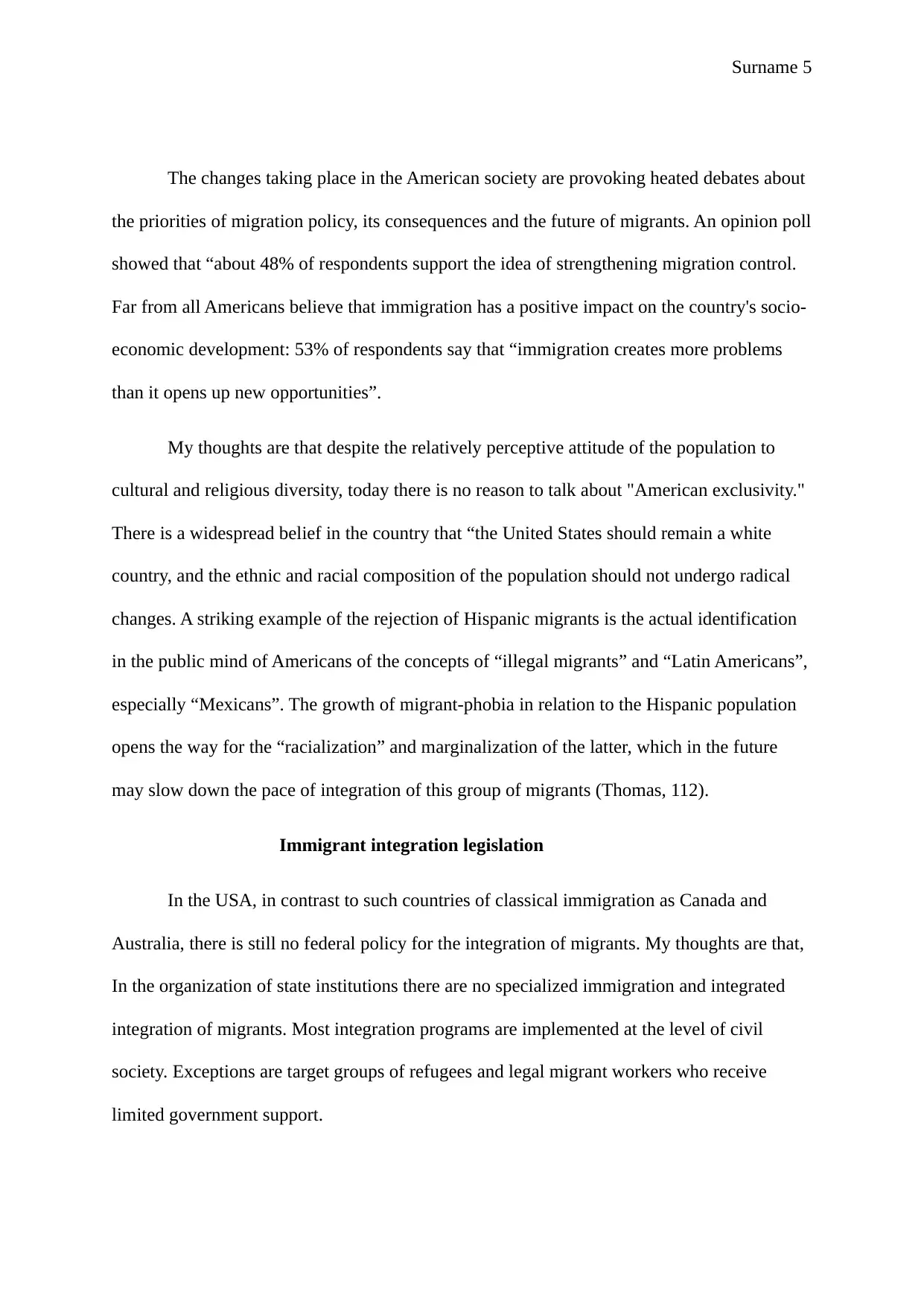
Surname 5
The changes taking place in the American society are provoking heated debates about
the priorities of migration policy, its consequences and the future of migrants. An opinion poll
showed that “about 48% of respondents support the idea of strengthening migration control.
Far from all Americans believe that immigration has a positive impact on the country's socio-
economic development: 53% of respondents say that “immigration creates more problems
than it opens up new opportunities”.
My thoughts are that despite the relatively perceptive attitude of the population to
cultural and religious diversity, today there is no reason to talk about "American exclusivity."
There is a widespread belief in the country that “the United States should remain a white
country, and the ethnic and racial composition of the population should not undergo radical
changes. A striking example of the rejection of Hispanic migrants is the actual identification
in the public mind of Americans of the concepts of “illegal migrants” and “Latin Americans”,
especially “Mexicans”. The growth of migrant-phobia in relation to the Hispanic population
opens the way for the “racialization” and marginalization of the latter, which in the future
may slow down the pace of integration of this group of migrants (Thomas, 112).
Immigrant integration legislation
In the USA, in contrast to such countries of classical immigration as Canada and
Australia, there is still no federal policy for the integration of migrants. My thoughts are that,
In the organization of state institutions there are no specialized immigration and integrated
integration of migrants. Most integration programs are implemented at the level of civil
society. Exceptions are target groups of refugees and legal migrant workers who receive
limited government support.
The changes taking place in the American society are provoking heated debates about
the priorities of migration policy, its consequences and the future of migrants. An opinion poll
showed that “about 48% of respondents support the idea of strengthening migration control.
Far from all Americans believe that immigration has a positive impact on the country's socio-
economic development: 53% of respondents say that “immigration creates more problems
than it opens up new opportunities”.
My thoughts are that despite the relatively perceptive attitude of the population to
cultural and religious diversity, today there is no reason to talk about "American exclusivity."
There is a widespread belief in the country that “the United States should remain a white
country, and the ethnic and racial composition of the population should not undergo radical
changes. A striking example of the rejection of Hispanic migrants is the actual identification
in the public mind of Americans of the concepts of “illegal migrants” and “Latin Americans”,
especially “Mexicans”. The growth of migrant-phobia in relation to the Hispanic population
opens the way for the “racialization” and marginalization of the latter, which in the future
may slow down the pace of integration of this group of migrants (Thomas, 112).
Immigrant integration legislation
In the USA, in contrast to such countries of classical immigration as Canada and
Australia, there is still no federal policy for the integration of migrants. My thoughts are that,
In the organization of state institutions there are no specialized immigration and integrated
integration of migrants. Most integration programs are implemented at the level of civil
society. Exceptions are target groups of refugees and legal migrant workers who receive
limited government support.
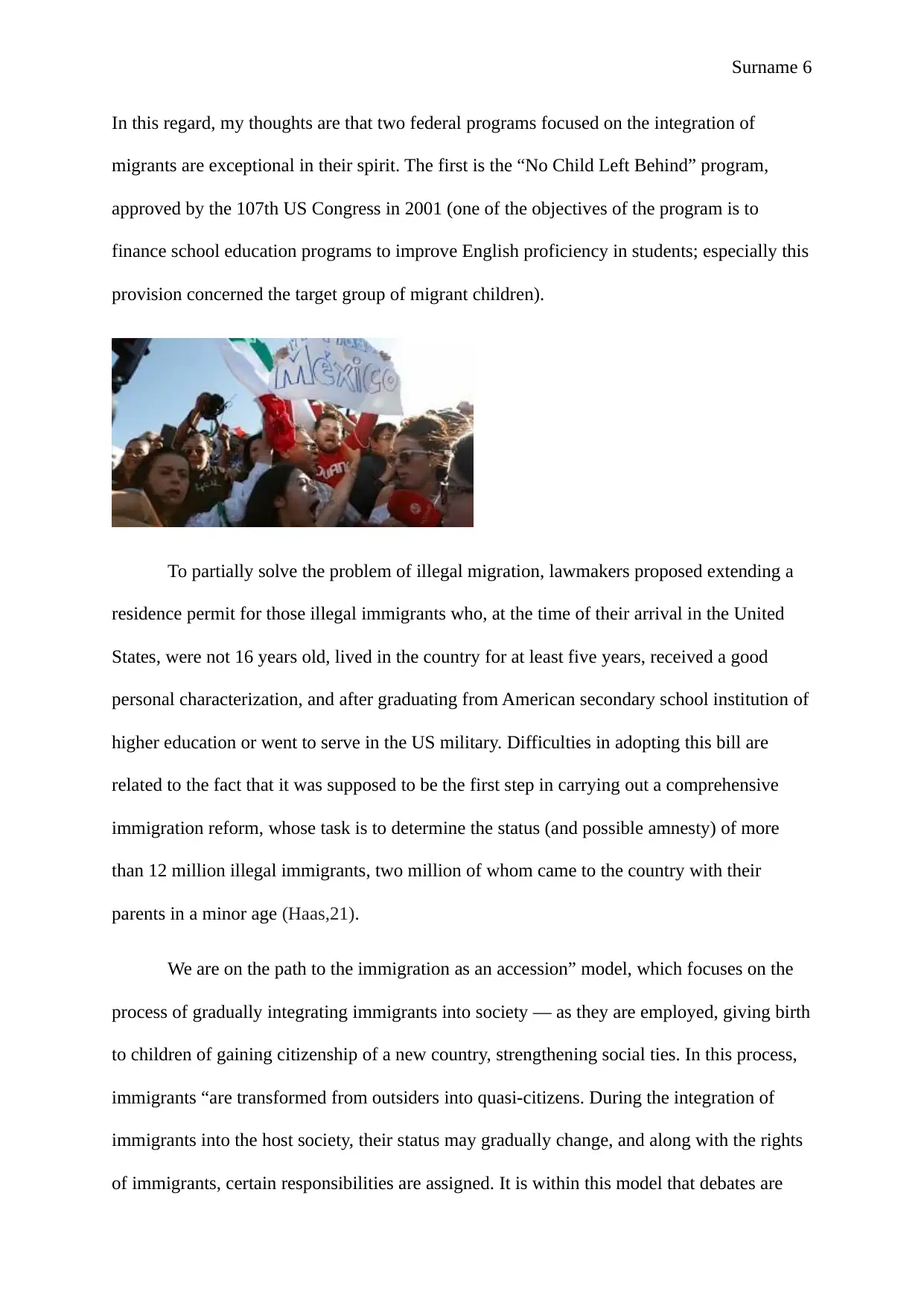
Surname 6
In this regard, my thoughts are that two federal programs focused on the integration of
migrants are exceptional in their spirit. The first is the “No Child Left Behind” program,
approved by the 107th US Congress in 2001 (one of the objectives of the program is to
finance school education programs to improve English proficiency in students; especially this
provision concerned the target group of migrant children).
To partially solve the problem of illegal migration, lawmakers proposed extending a
residence permit for those illegal immigrants who, at the time of their arrival in the United
States, were not 16 years old, lived in the country for at least five years, received a good
personal characterization, and after graduating from American secondary school institution of
higher education or went to serve in the US military. Difficulties in adopting this bill are
related to the fact that it was supposed to be the first step in carrying out a comprehensive
immigration reform, whose task is to determine the status (and possible amnesty) of more
than 12 million illegal immigrants, two million of whom came to the country with their
parents in a minor age (Haas,21).
We are on the path to the immigration as an accession” model, which focuses on the
process of gradually integrating immigrants into society — as they are employed, giving birth
to children of gaining citizenship of a new country, strengthening social ties. In this process,
immigrants “are transformed from outsiders into quasi-citizens. During the integration of
immigrants into the host society, their status may gradually change, and along with the rights
of immigrants, certain responsibilities are assigned. It is within this model that debates are
In this regard, my thoughts are that two federal programs focused on the integration of
migrants are exceptional in their spirit. The first is the “No Child Left Behind” program,
approved by the 107th US Congress in 2001 (one of the objectives of the program is to
finance school education programs to improve English proficiency in students; especially this
provision concerned the target group of migrant children).
To partially solve the problem of illegal migration, lawmakers proposed extending a
residence permit for those illegal immigrants who, at the time of their arrival in the United
States, were not 16 years old, lived in the country for at least five years, received a good
personal characterization, and after graduating from American secondary school institution of
higher education or went to serve in the US military. Difficulties in adopting this bill are
related to the fact that it was supposed to be the first step in carrying out a comprehensive
immigration reform, whose task is to determine the status (and possible amnesty) of more
than 12 million illegal immigrants, two million of whom came to the country with their
parents in a minor age (Haas,21).
We are on the path to the immigration as an accession” model, which focuses on the
process of gradually integrating immigrants into society — as they are employed, giving birth
to children of gaining citizenship of a new country, strengthening social ties. In this process,
immigrants “are transformed from outsiders into quasi-citizens. During the integration of
immigrants into the host society, their status may gradually change, and along with the rights
of immigrants, certain responsibilities are assigned. It is within this model that debates are
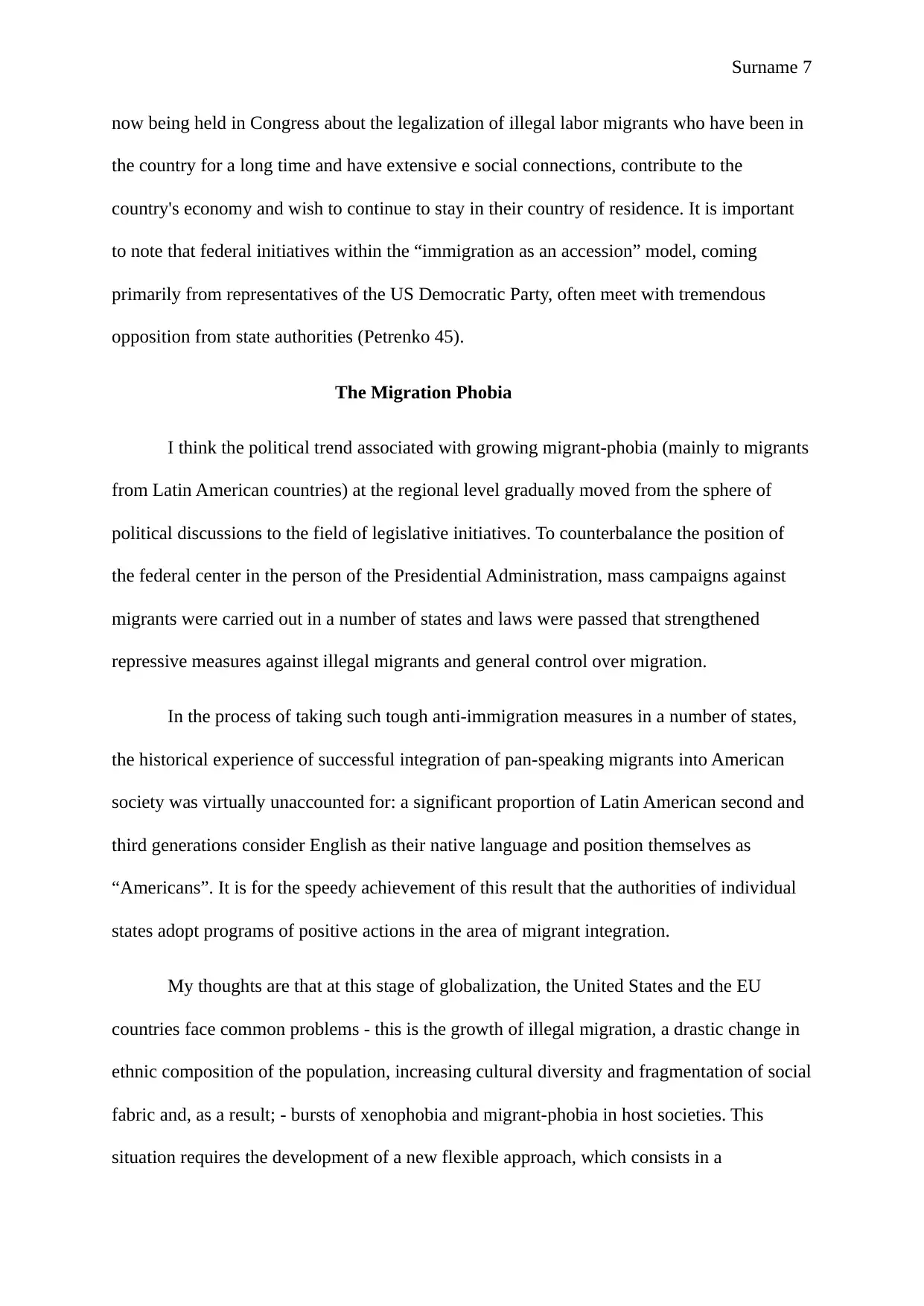
Surname 7
now being held in Congress about the legalization of illegal labor migrants who have been in
the country for a long time and have extensive e social connections, contribute to the
country's economy and wish to continue to stay in their country of residence. It is important
to note that federal initiatives within the “immigration as an accession” model, coming
primarily from representatives of the US Democratic Party, often meet with tremendous
opposition from state authorities (Petrenko 45).
The Migration Phobia
I think the political trend associated with growing migrant-phobia (mainly to migrants
from Latin American countries) at the regional level gradually moved from the sphere of
political discussions to the field of legislative initiatives. To counterbalance the position of
the federal center in the person of the Presidential Administration, mass campaigns against
migrants were carried out in a number of states and laws were passed that strengthened
repressive measures against illegal migrants and general control over migration.
In the process of taking such tough anti-immigration measures in a number of states,
the historical experience of successful integration of pan-speaking migrants into American
society was virtually unaccounted for: a significant proportion of Latin American second and
third generations consider English as their native language and position themselves as
“Americans”. It is for the speedy achievement of this result that the authorities of individual
states adopt programs of positive actions in the area of migrant integration.
My thoughts are that at this stage of globalization, the United States and the EU
countries face common problems - this is the growth of illegal migration, a drastic change in
ethnic composition of the population, increasing cultural diversity and fragmentation of social
fabric and, as a result; - bursts of xenophobia and migrant-phobia in host societies. This
situation requires the development of a new flexible approach, which consists in a
now being held in Congress about the legalization of illegal labor migrants who have been in
the country for a long time and have extensive e social connections, contribute to the
country's economy and wish to continue to stay in their country of residence. It is important
to note that federal initiatives within the “immigration as an accession” model, coming
primarily from representatives of the US Democratic Party, often meet with tremendous
opposition from state authorities (Petrenko 45).
The Migration Phobia
I think the political trend associated with growing migrant-phobia (mainly to migrants
from Latin American countries) at the regional level gradually moved from the sphere of
political discussions to the field of legislative initiatives. To counterbalance the position of
the federal center in the person of the Presidential Administration, mass campaigns against
migrants were carried out in a number of states and laws were passed that strengthened
repressive measures against illegal migrants and general control over migration.
In the process of taking such tough anti-immigration measures in a number of states,
the historical experience of successful integration of pan-speaking migrants into American
society was virtually unaccounted for: a significant proportion of Latin American second and
third generations consider English as their native language and position themselves as
“Americans”. It is for the speedy achievement of this result that the authorities of individual
states adopt programs of positive actions in the area of migrant integration.
My thoughts are that at this stage of globalization, the United States and the EU
countries face common problems - this is the growth of illegal migration, a drastic change in
ethnic composition of the population, increasing cultural diversity and fragmentation of social
fabric and, as a result; - bursts of xenophobia and migrant-phobia in host societies. This
situation requires the development of a new flexible approach, which consists in a
Paraphrase This Document
Need a fresh take? Get an instant paraphrase of this document with our AI Paraphraser
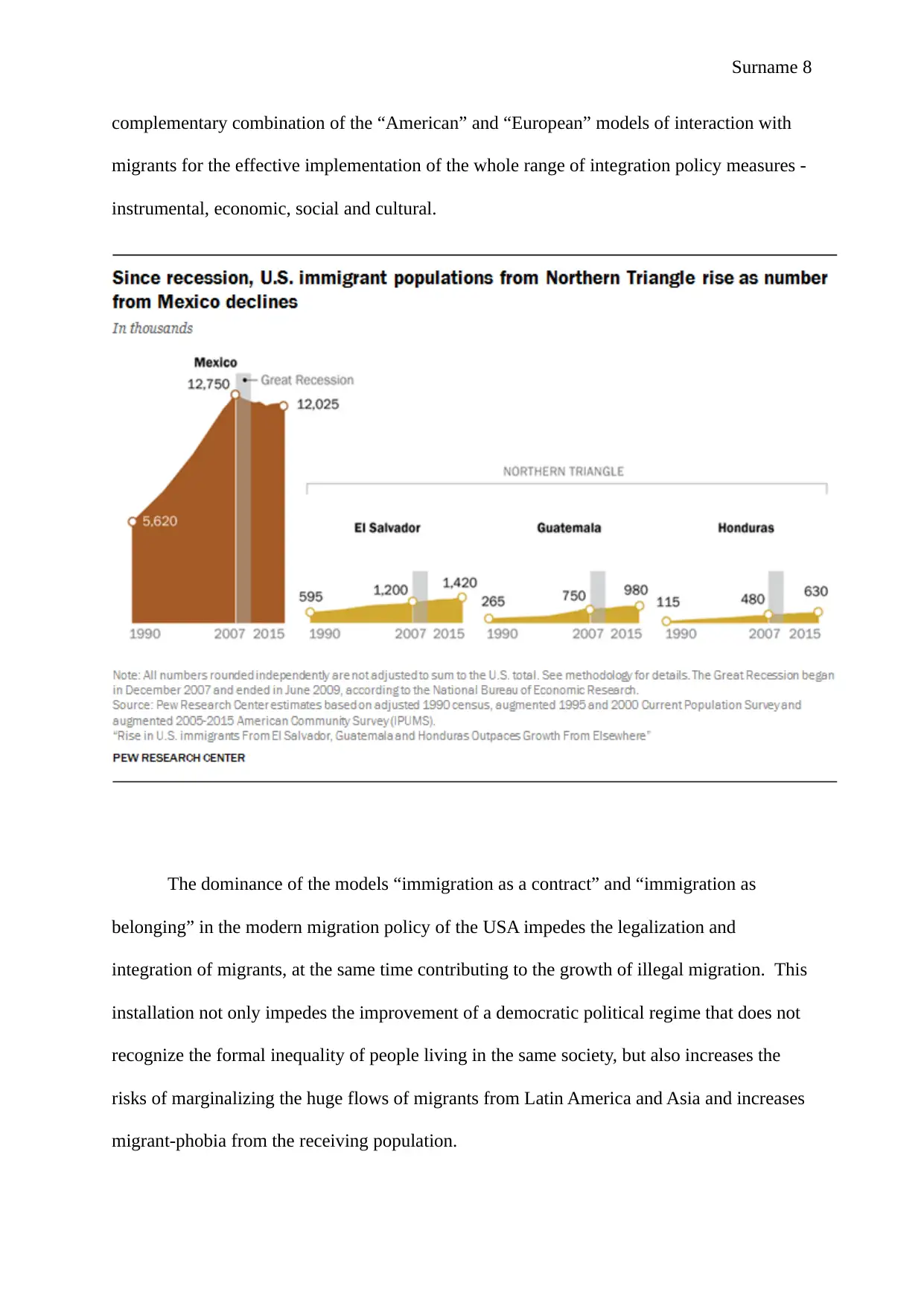
Surname 8
complementary combination of the “American” and “European” models of interaction with
migrants for the effective implementation of the whole range of integration policy measures -
instrumental, economic, social and cultural.
The dominance of the models “immigration as a contract” and “immigration as
belonging” in the modern migration policy of the USA impedes the legalization and
integration of migrants, at the same time contributing to the growth of illegal migration. This
installation not only impedes the improvement of a democratic political regime that does not
recognize the formal inequality of people living in the same society, but also increases the
risks of marginalizing the huge flows of migrants from Latin America and Asia and increases
migrant-phobia from the receiving population.
complementary combination of the “American” and “European” models of interaction with
migrants for the effective implementation of the whole range of integration policy measures -
instrumental, economic, social and cultural.
The dominance of the models “immigration as a contract” and “immigration as
belonging” in the modern migration policy of the USA impedes the legalization and
integration of migrants, at the same time contributing to the growth of illegal migration. This
installation not only impedes the improvement of a democratic political regime that does not
recognize the formal inequality of people living in the same society, but also increases the
risks of marginalizing the huge flows of migrants from Latin America and Asia and increases
migrant-phobia from the receiving population.
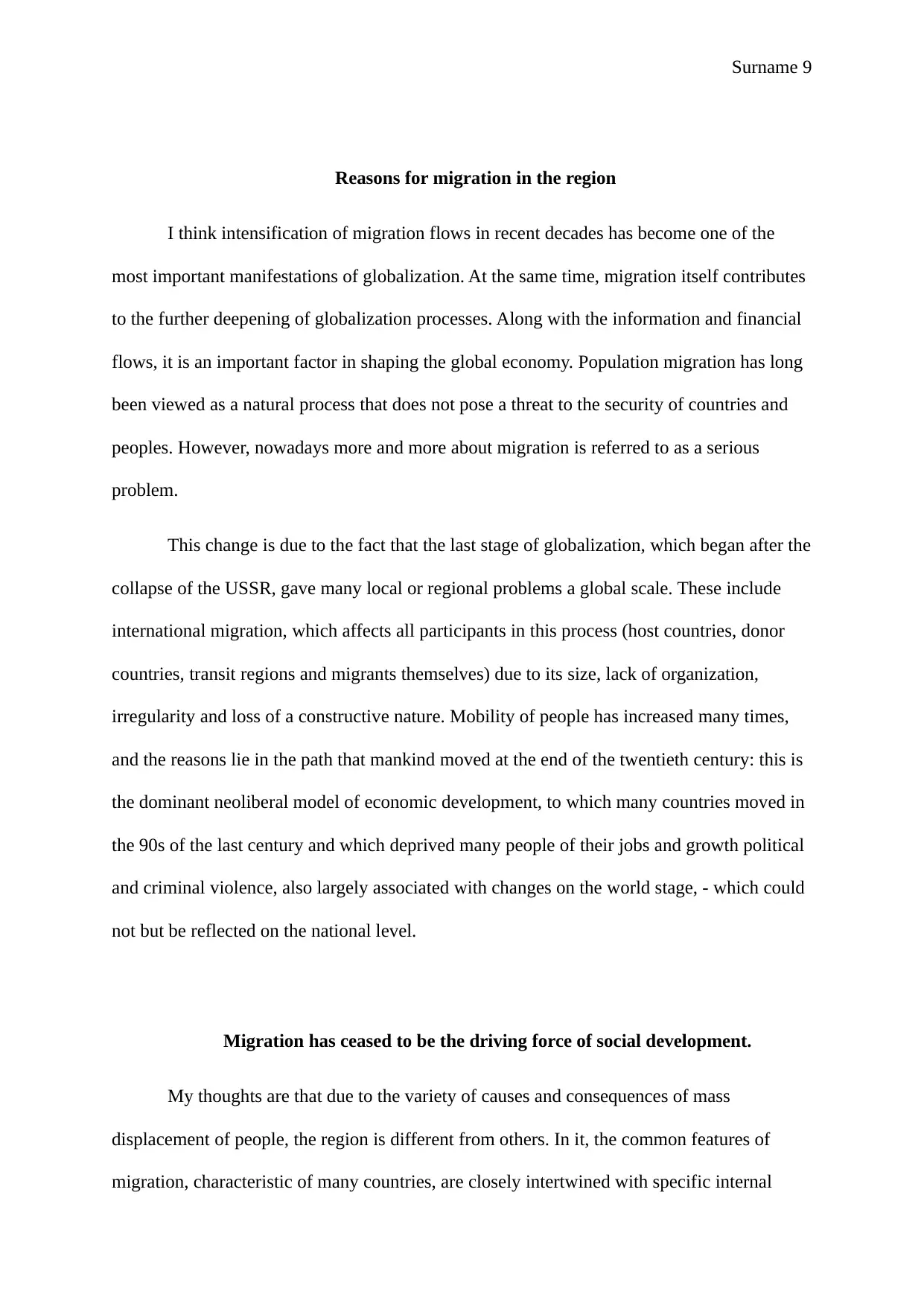
Surname 9
Reasons for migration in the region
I think intensification of migration flows in recent decades has become one of the
most important manifestations of globalization. At the same time, migration itself contributes
to the further deepening of globalization processes. Along with the information and financial
flows, it is an important factor in shaping the global economy. Population migration has long
been viewed as a natural process that does not pose a threat to the security of countries and
peoples. However, nowadays more and more about migration is referred to as a serious
problem.
This change is due to the fact that the last stage of globalization, which began after the
collapse of the USSR, gave many local or regional problems a global scale. These include
international migration, which affects all participants in this process (host countries, donor
countries, transit regions and migrants themselves) due to its size, lack of organization,
irregularity and loss of a constructive nature. Mobility of people has increased many times,
and the reasons lie in the path that mankind moved at the end of the twentieth century: this is
the dominant neoliberal model of economic development, to which many countries moved in
the 90s of the last century and which deprived many people of their jobs and growth political
and criminal violence, also largely associated with changes on the world stage, - which could
not but be reflected on the national level.
Migration has ceased to be the driving force of social development.
My thoughts are that due to the variety of causes and consequences of mass
displacement of people, the region is different from others. In it, the common features of
migration, characteristic of many countries, are closely intertwined with specific internal
Reasons for migration in the region
I think intensification of migration flows in recent decades has become one of the
most important manifestations of globalization. At the same time, migration itself contributes
to the further deepening of globalization processes. Along with the information and financial
flows, it is an important factor in shaping the global economy. Population migration has long
been viewed as a natural process that does not pose a threat to the security of countries and
peoples. However, nowadays more and more about migration is referred to as a serious
problem.
This change is due to the fact that the last stage of globalization, which began after the
collapse of the USSR, gave many local or regional problems a global scale. These include
international migration, which affects all participants in this process (host countries, donor
countries, transit regions and migrants themselves) due to its size, lack of organization,
irregularity and loss of a constructive nature. Mobility of people has increased many times,
and the reasons lie in the path that mankind moved at the end of the twentieth century: this is
the dominant neoliberal model of economic development, to which many countries moved in
the 90s of the last century and which deprived many people of their jobs and growth political
and criminal violence, also largely associated with changes on the world stage, - which could
not but be reflected on the national level.
Migration has ceased to be the driving force of social development.
My thoughts are that due to the variety of causes and consequences of mass
displacement of people, the region is different from others. In it, the common features of
migration, characteristic of many countries, are closely intertwined with specific internal
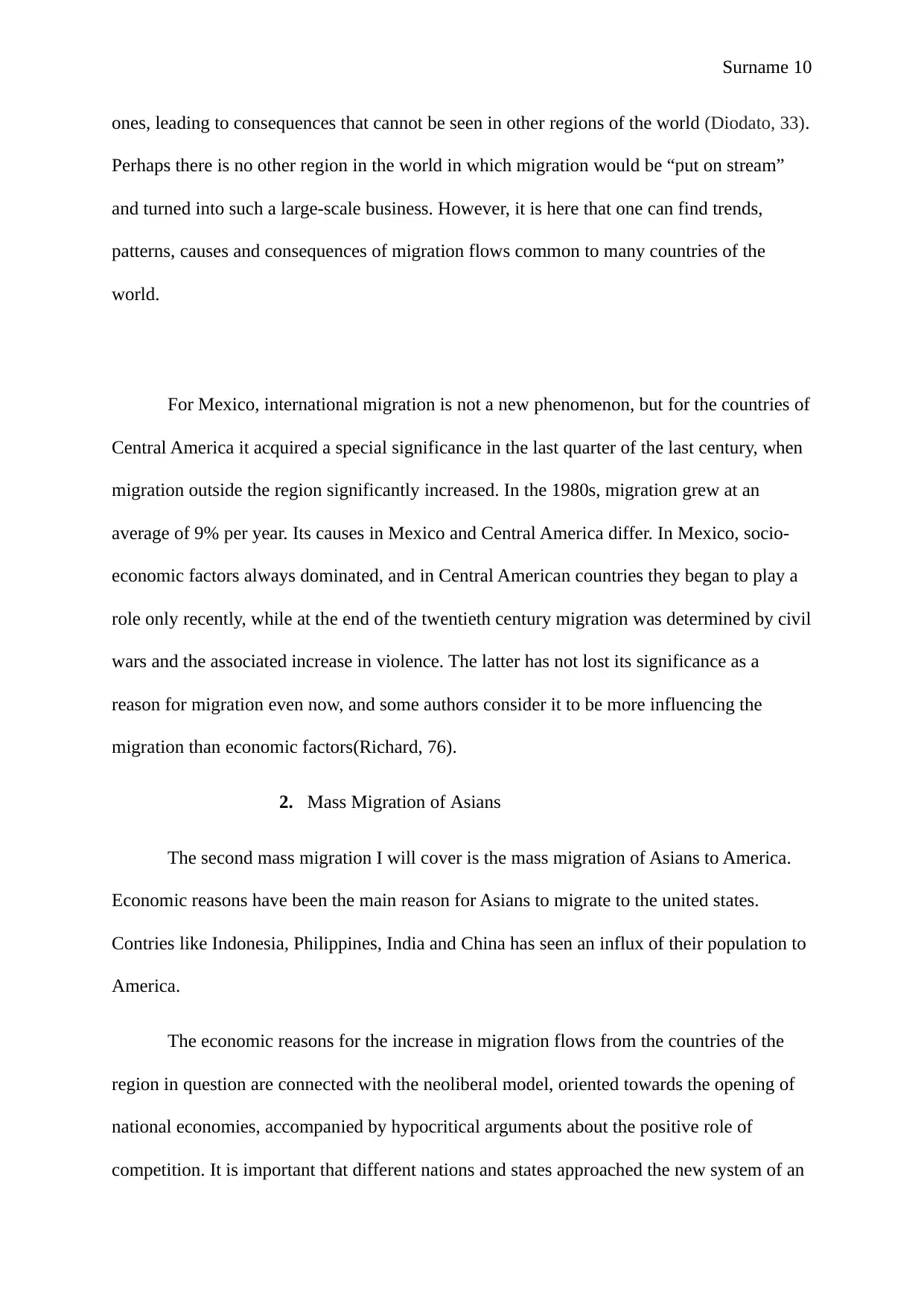
Surname 10
ones, leading to consequences that cannot be seen in other regions of the world (Diodato, 33).
Perhaps there is no other region in the world in which migration would be “put on stream”
and turned into such a large-scale business. However, it is here that one can find trends,
patterns, causes and consequences of migration flows common to many countries of the
world.
For Mexico, international migration is not a new phenomenon, but for the countries of
Central America it acquired a special significance in the last quarter of the last century, when
migration outside the region significantly increased. In the 1980s, migration grew at an
average of 9% per year. Its causes in Mexico and Central America differ. In Mexico, socio-
economic factors always dominated, and in Central American countries they began to play a
role only recently, while at the end of the twentieth century migration was determined by civil
wars and the associated increase in violence. The latter has not lost its significance as a
reason for migration even now, and some authors consider it to be more influencing the
migration than economic factors(Richard, 76).
2. Mass Migration of Asians
The second mass migration I will cover is the mass migration of Asians to America.
Economic reasons have been the main reason for Asians to migrate to the united states.
Contries like Indonesia, Philippines, India and China has seen an influx of their population to
America.
The economic reasons for the increase in migration flows from the countries of the
region in question are connected with the neoliberal model, oriented towards the opening of
national economies, accompanied by hypocritical arguments about the positive role of
competition. It is important that different nations and states approached the new system of an
ones, leading to consequences that cannot be seen in other regions of the world (Diodato, 33).
Perhaps there is no other region in the world in which migration would be “put on stream”
and turned into such a large-scale business. However, it is here that one can find trends,
patterns, causes and consequences of migration flows common to many countries of the
world.
For Mexico, international migration is not a new phenomenon, but for the countries of
Central America it acquired a special significance in the last quarter of the last century, when
migration outside the region significantly increased. In the 1980s, migration grew at an
average of 9% per year. Its causes in Mexico and Central America differ. In Mexico, socio-
economic factors always dominated, and in Central American countries they began to play a
role only recently, while at the end of the twentieth century migration was determined by civil
wars and the associated increase in violence. The latter has not lost its significance as a
reason for migration even now, and some authors consider it to be more influencing the
migration than economic factors(Richard, 76).
2. Mass Migration of Asians
The second mass migration I will cover is the mass migration of Asians to America.
Economic reasons have been the main reason for Asians to migrate to the united states.
Contries like Indonesia, Philippines, India and China has seen an influx of their population to
America.
The economic reasons for the increase in migration flows from the countries of the
region in question are connected with the neoliberal model, oriented towards the opening of
national economies, accompanied by hypocritical arguments about the positive role of
competition. It is important that different nations and states approached the new system of an
Secure Best Marks with AI Grader
Need help grading? Try our AI Grader for instant feedback on your assignments.
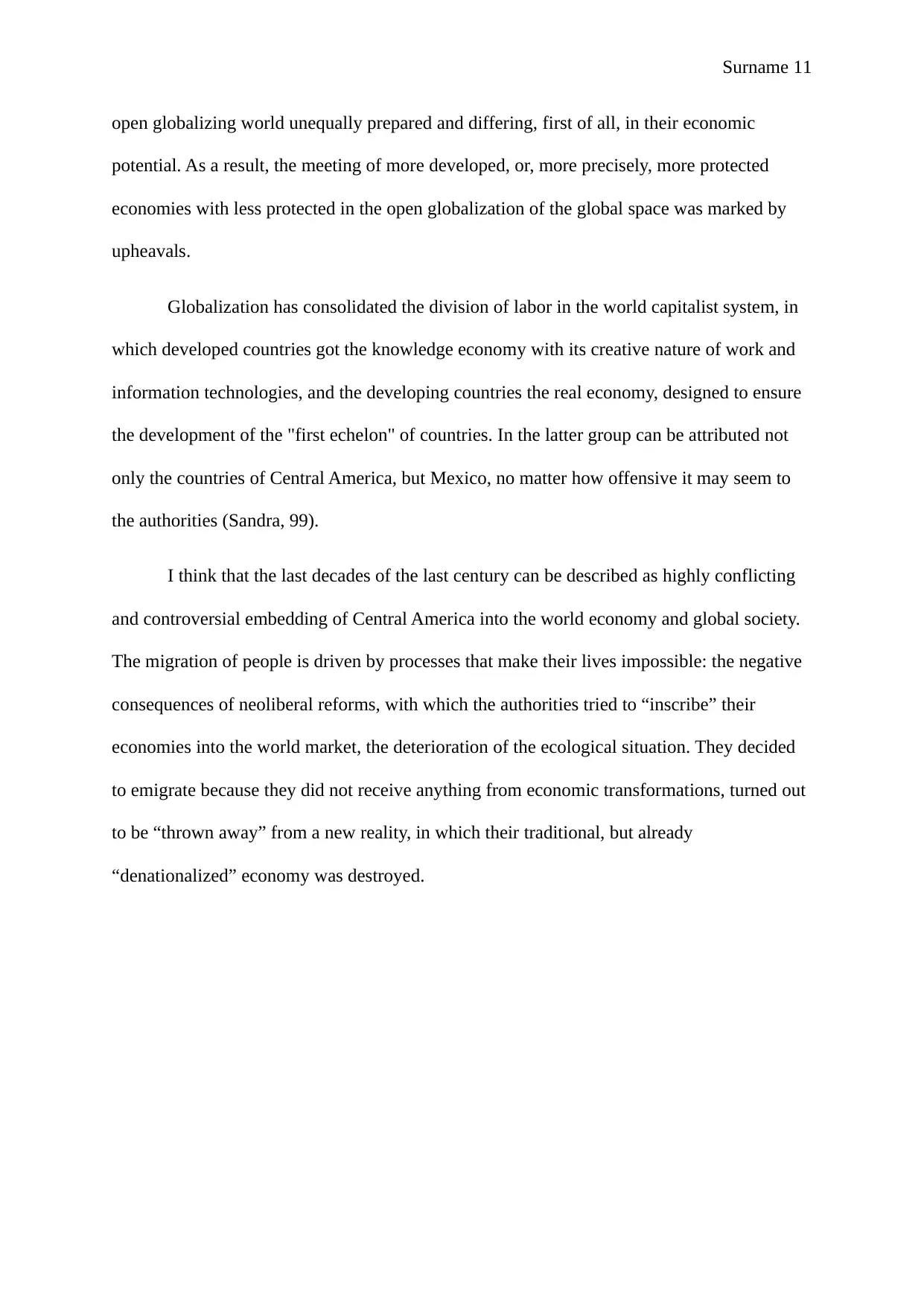
Surname 11
open globalizing world unequally prepared and differing, first of all, in their economic
potential. As a result, the meeting of more developed, or, more precisely, more protected
economies with less protected in the open globalization of the global space was marked by
upheavals.
Globalization has consolidated the division of labor in the world capitalist system, in
which developed countries got the knowledge economy with its creative nature of work and
information technologies, and the developing countries the real economy, designed to ensure
the development of the "first echelon" of countries. In the latter group can be attributed not
only the countries of Central America, but Mexico, no matter how offensive it may seem to
the authorities (Sandra, 99).
I think that the last decades of the last century can be described as highly conflicting
and controversial embedding of Central America into the world economy and global society.
The migration of people is driven by processes that make their lives impossible: the negative
consequences of neoliberal reforms, with which the authorities tried to “inscribe” their
economies into the world market, the deterioration of the ecological situation. They decided
to emigrate because they did not receive anything from economic transformations, turned out
to be “thrown away” from a new reality, in which their traditional, but already
“denationalized” economy was destroyed.
open globalizing world unequally prepared and differing, first of all, in their economic
potential. As a result, the meeting of more developed, or, more precisely, more protected
economies with less protected in the open globalization of the global space was marked by
upheavals.
Globalization has consolidated the division of labor in the world capitalist system, in
which developed countries got the knowledge economy with its creative nature of work and
information technologies, and the developing countries the real economy, designed to ensure
the development of the "first echelon" of countries. In the latter group can be attributed not
only the countries of Central America, but Mexico, no matter how offensive it may seem to
the authorities (Sandra, 99).
I think that the last decades of the last century can be described as highly conflicting
and controversial embedding of Central America into the world economy and global society.
The migration of people is driven by processes that make their lives impossible: the negative
consequences of neoliberal reforms, with which the authorities tried to “inscribe” their
economies into the world market, the deterioration of the ecological situation. They decided
to emigrate because they did not receive anything from economic transformations, turned out
to be “thrown away” from a new reality, in which their traditional, but already
“denationalized” economy was destroyed.
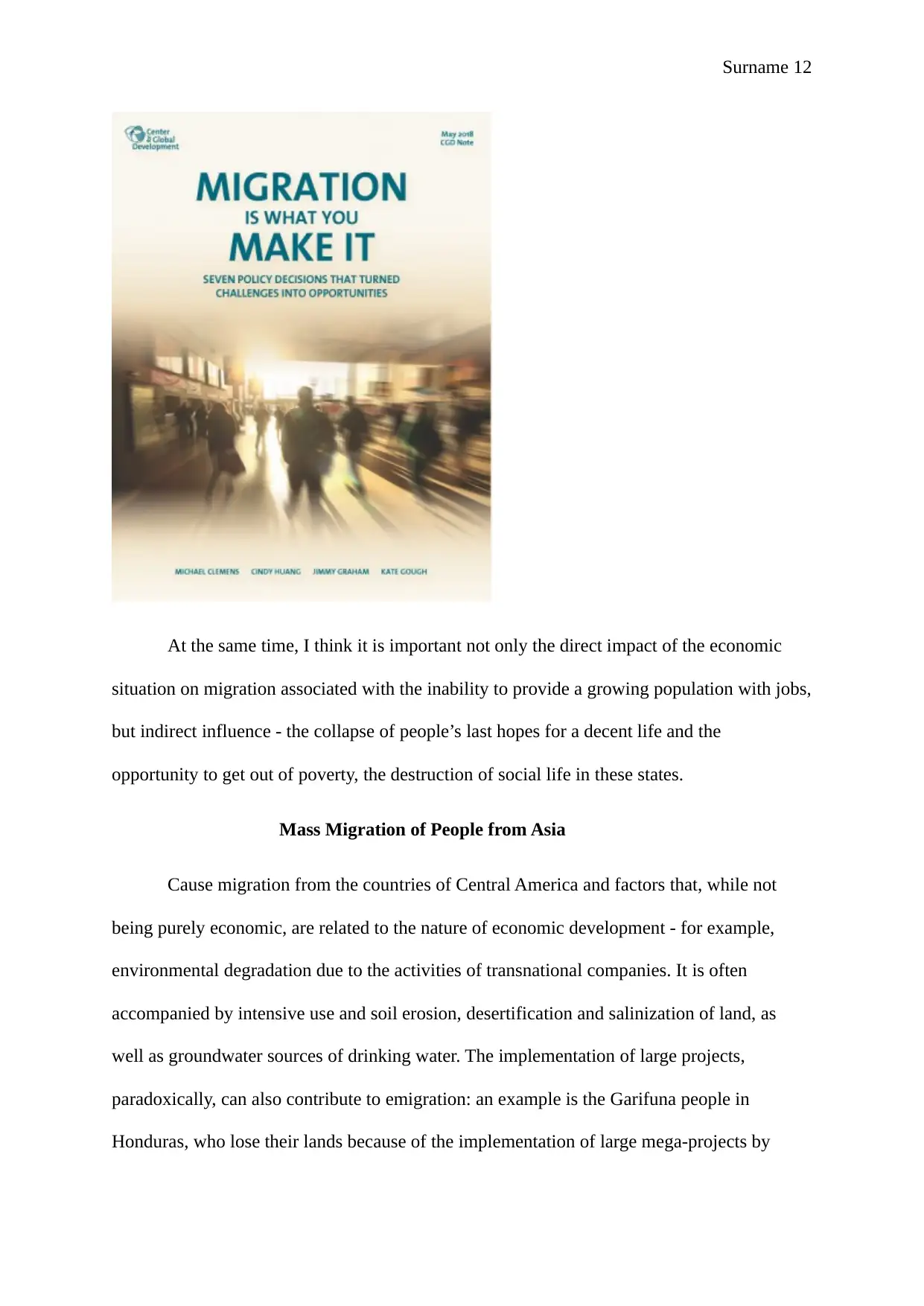
Surname 12
At the same time, I think it is important not only the direct impact of the economic
situation on migration associated with the inability to provide a growing population with jobs,
but indirect influence - the collapse of people’s last hopes for a decent life and the
opportunity to get out of poverty, the destruction of social life in these states.
Mass Migration of People from Asia
Cause migration from the countries of Central America and factors that, while not
being purely economic, are related to the nature of economic development - for example,
environmental degradation due to the activities of transnational companies. It is often
accompanied by intensive use and soil erosion, desertification and salinization of land, as
well as groundwater sources of drinking water. The implementation of large projects,
paradoxically, can also contribute to emigration: an example is the Garifuna people in
Honduras, who lose their lands because of the implementation of large mega-projects by
At the same time, I think it is important not only the direct impact of the economic
situation on migration associated with the inability to provide a growing population with jobs,
but indirect influence - the collapse of people’s last hopes for a decent life and the
opportunity to get out of poverty, the destruction of social life in these states.
Mass Migration of People from Asia
Cause migration from the countries of Central America and factors that, while not
being purely economic, are related to the nature of economic development - for example,
environmental degradation due to the activities of transnational companies. It is often
accompanied by intensive use and soil erosion, desertification and salinization of land, as
well as groundwater sources of drinking water. The implementation of large projects,
paradoxically, can also contribute to emigration: an example is the Garifuna people in
Honduras, who lose their lands because of the implementation of large mega-projects by
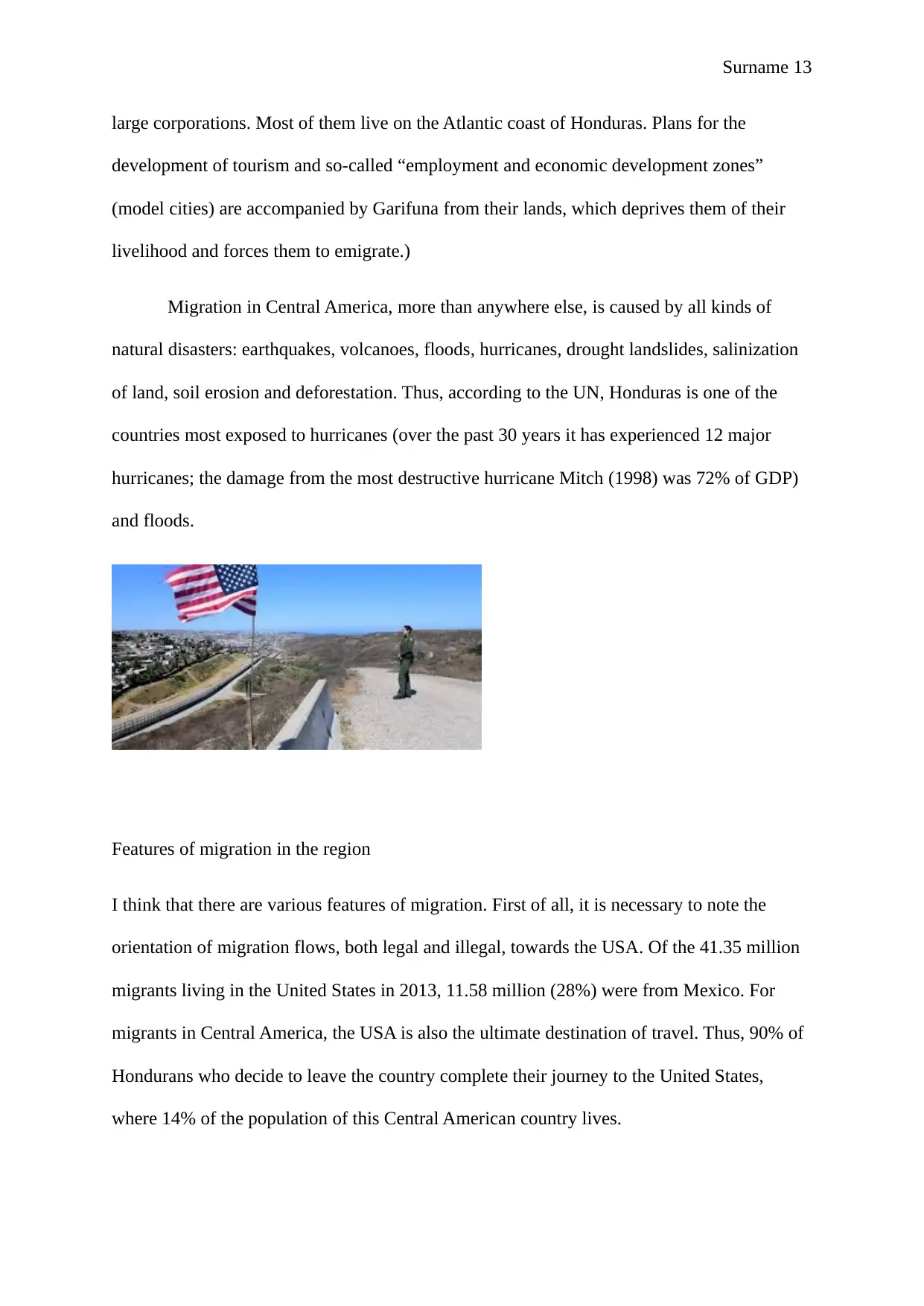
Surname 13
large corporations. Most of them live on the Atlantic coast of Honduras. Plans for the
development of tourism and so-called “employment and economic development zones”
(model cities) are accompanied by Garifuna from their lands, which deprives them of their
livelihood and forces them to emigrate.)
Migration in Central America, more than anywhere else, is caused by all kinds of
natural disasters: earthquakes, volcanoes, floods, hurricanes, drought landslides, salinization
of land, soil erosion and deforestation. Thus, according to the UN, Honduras is one of the
countries most exposed to hurricanes (over the past 30 years it has experienced 12 major
hurricanes; the damage from the most destructive hurricane Mitch (1998) was 72% of GDP)
and floods.
Features of migration in the region
I think that there are various features of migration. First of all, it is necessary to note the
orientation of migration flows, both legal and illegal, towards the USA. Of the 41.35 million
migrants living in the United States in 2013, 11.58 million (28%) were from Mexico. For
migrants in Central America, the USA is also the ultimate destination of travel. Thus, 90% of
Hondurans who decide to leave the country complete their journey to the United States,
where 14% of the population of this Central American country lives.
large corporations. Most of them live on the Atlantic coast of Honduras. Plans for the
development of tourism and so-called “employment and economic development zones”
(model cities) are accompanied by Garifuna from their lands, which deprives them of their
livelihood and forces them to emigrate.)
Migration in Central America, more than anywhere else, is caused by all kinds of
natural disasters: earthquakes, volcanoes, floods, hurricanes, drought landslides, salinization
of land, soil erosion and deforestation. Thus, according to the UN, Honduras is one of the
countries most exposed to hurricanes (over the past 30 years it has experienced 12 major
hurricanes; the damage from the most destructive hurricane Mitch (1998) was 72% of GDP)
and floods.
Features of migration in the region
I think that there are various features of migration. First of all, it is necessary to note the
orientation of migration flows, both legal and illegal, towards the USA. Of the 41.35 million
migrants living in the United States in 2013, 11.58 million (28%) were from Mexico. For
migrants in Central America, the USA is also the ultimate destination of travel. Thus, 90% of
Hondurans who decide to leave the country complete their journey to the United States,
where 14% of the population of this Central American country lives.
Paraphrase This Document
Need a fresh take? Get an instant paraphrase of this document with our AI Paraphraser
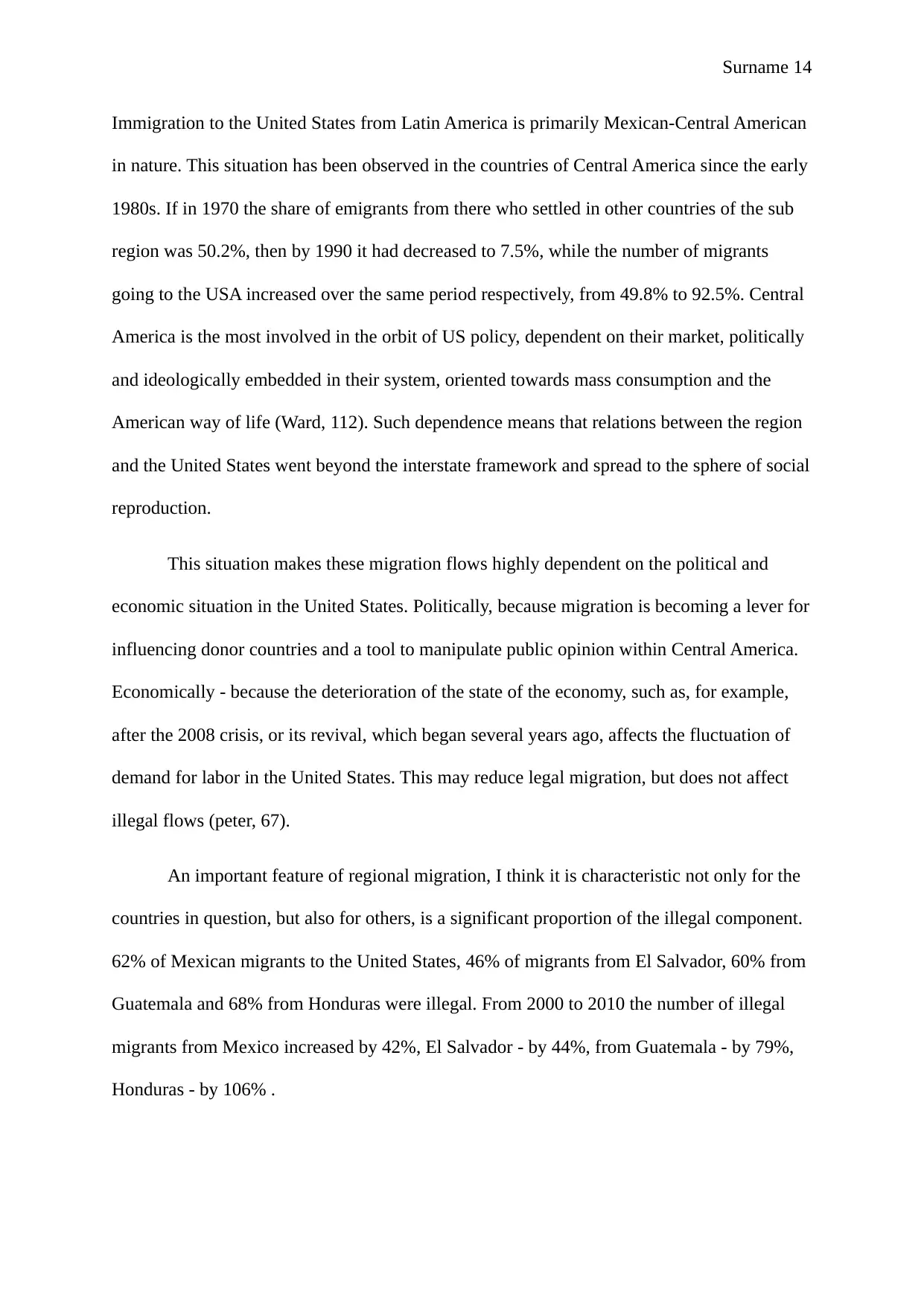
Surname 14
Immigration to the United States from Latin America is primarily Mexican-Central American
in nature. This situation has been observed in the countries of Central America since the early
1980s. If in 1970 the share of emigrants from there who settled in other countries of the sub
region was 50.2%, then by 1990 it had decreased to 7.5%, while the number of migrants
going to the USA increased over the same period respectively, from 49.8% to 92.5%. Central
America is the most involved in the orbit of US policy, dependent on their market, politically
and ideologically embedded in their system, oriented towards mass consumption and the
American way of life (Ward, 112). Such dependence means that relations between the region
and the United States went beyond the interstate framework and spread to the sphere of social
reproduction.
This situation makes these migration flows highly dependent on the political and
economic situation in the United States. Politically, because migration is becoming a lever for
influencing donor countries and a tool to manipulate public opinion within Central America.
Economically - because the deterioration of the state of the economy, such as, for example,
after the 2008 crisis, or its revival, which began several years ago, affects the fluctuation of
demand for labor in the United States. This may reduce legal migration, but does not affect
illegal flows (peter, 67).
An important feature of regional migration, I think it is characteristic not only for the
countries in question, but also for others, is a significant proportion of the illegal component.
62% of Mexican migrants to the United States, 46% of migrants from El Salvador, 60% from
Guatemala and 68% from Honduras were illegal. From 2000 to 2010 the number of illegal
migrants from Mexico increased by 42%, El Salvador - by 44%, from Guatemala - by 79%,
Honduras - by 106% .
Immigration to the United States from Latin America is primarily Mexican-Central American
in nature. This situation has been observed in the countries of Central America since the early
1980s. If in 1970 the share of emigrants from there who settled in other countries of the sub
region was 50.2%, then by 1990 it had decreased to 7.5%, while the number of migrants
going to the USA increased over the same period respectively, from 49.8% to 92.5%. Central
America is the most involved in the orbit of US policy, dependent on their market, politically
and ideologically embedded in their system, oriented towards mass consumption and the
American way of life (Ward, 112). Such dependence means that relations between the region
and the United States went beyond the interstate framework and spread to the sphere of social
reproduction.
This situation makes these migration flows highly dependent on the political and
economic situation in the United States. Politically, because migration is becoming a lever for
influencing donor countries and a tool to manipulate public opinion within Central America.
Economically - because the deterioration of the state of the economy, such as, for example,
after the 2008 crisis, or its revival, which began several years ago, affects the fluctuation of
demand for labor in the United States. This may reduce legal migration, but does not affect
illegal flows (peter, 67).
An important feature of regional migration, I think it is characteristic not only for the
countries in question, but also for others, is a significant proportion of the illegal component.
62% of Mexican migrants to the United States, 46% of migrants from El Salvador, 60% from
Guatemala and 68% from Honduras were illegal. From 2000 to 2010 the number of illegal
migrants from Mexico increased by 42%, El Salvador - by 44%, from Guatemala - by 79%,
Honduras - by 106% .
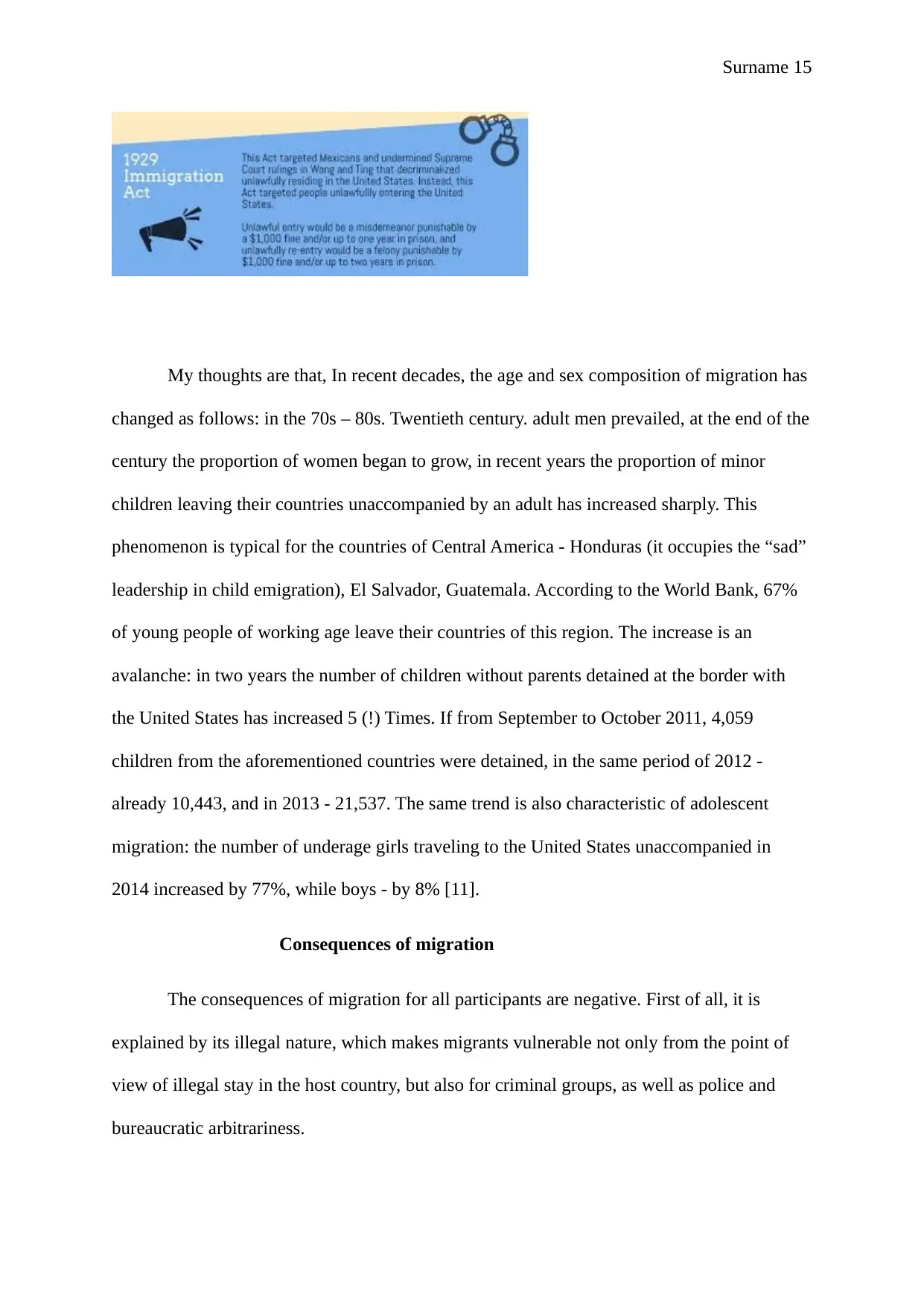
Surname 15
My thoughts are that, In recent decades, the age and sex composition of migration has
changed as follows: in the 70s – 80s. Twentieth century. adult men prevailed, at the end of the
century the proportion of women began to grow, in recent years the proportion of minor
children leaving their countries unaccompanied by an adult has increased sharply. This
phenomenon is typical for the countries of Central America - Honduras (it occupies the “sad”
leadership in child emigration), El Salvador, Guatemala. According to the World Bank, 67%
of young people of working age leave their countries of this region. The increase is an
avalanche: in two years the number of children without parents detained at the border with
the United States has increased 5 (!) Times. If from September to October 2011, 4,059
children from the aforementioned countries were detained, in the same period of 2012 -
already 10,443, and in 2013 - 21,537. The same trend is also characteristic of adolescent
migration: the number of underage girls traveling to the United States unaccompanied in
2014 increased by 77%, while boys - by 8% [11].
Consequences of migration
The consequences of migration for all participants are negative. First of all, it is
explained by its illegal nature, which makes migrants vulnerable not only from the point of
view of illegal stay in the host country, but also for criminal groups, as well as police and
bureaucratic arbitrariness.
My thoughts are that, In recent decades, the age and sex composition of migration has
changed as follows: in the 70s – 80s. Twentieth century. adult men prevailed, at the end of the
century the proportion of women began to grow, in recent years the proportion of minor
children leaving their countries unaccompanied by an adult has increased sharply. This
phenomenon is typical for the countries of Central America - Honduras (it occupies the “sad”
leadership in child emigration), El Salvador, Guatemala. According to the World Bank, 67%
of young people of working age leave their countries of this region. The increase is an
avalanche: in two years the number of children without parents detained at the border with
the United States has increased 5 (!) Times. If from September to October 2011, 4,059
children from the aforementioned countries were detained, in the same period of 2012 -
already 10,443, and in 2013 - 21,537. The same trend is also characteristic of adolescent
migration: the number of underage girls traveling to the United States unaccompanied in
2014 increased by 77%, while boys - by 8% [11].
Consequences of migration
The consequences of migration for all participants are negative. First of all, it is
explained by its illegal nature, which makes migrants vulnerable not only from the point of
view of illegal stay in the host country, but also for criminal groups, as well as police and
bureaucratic arbitrariness.
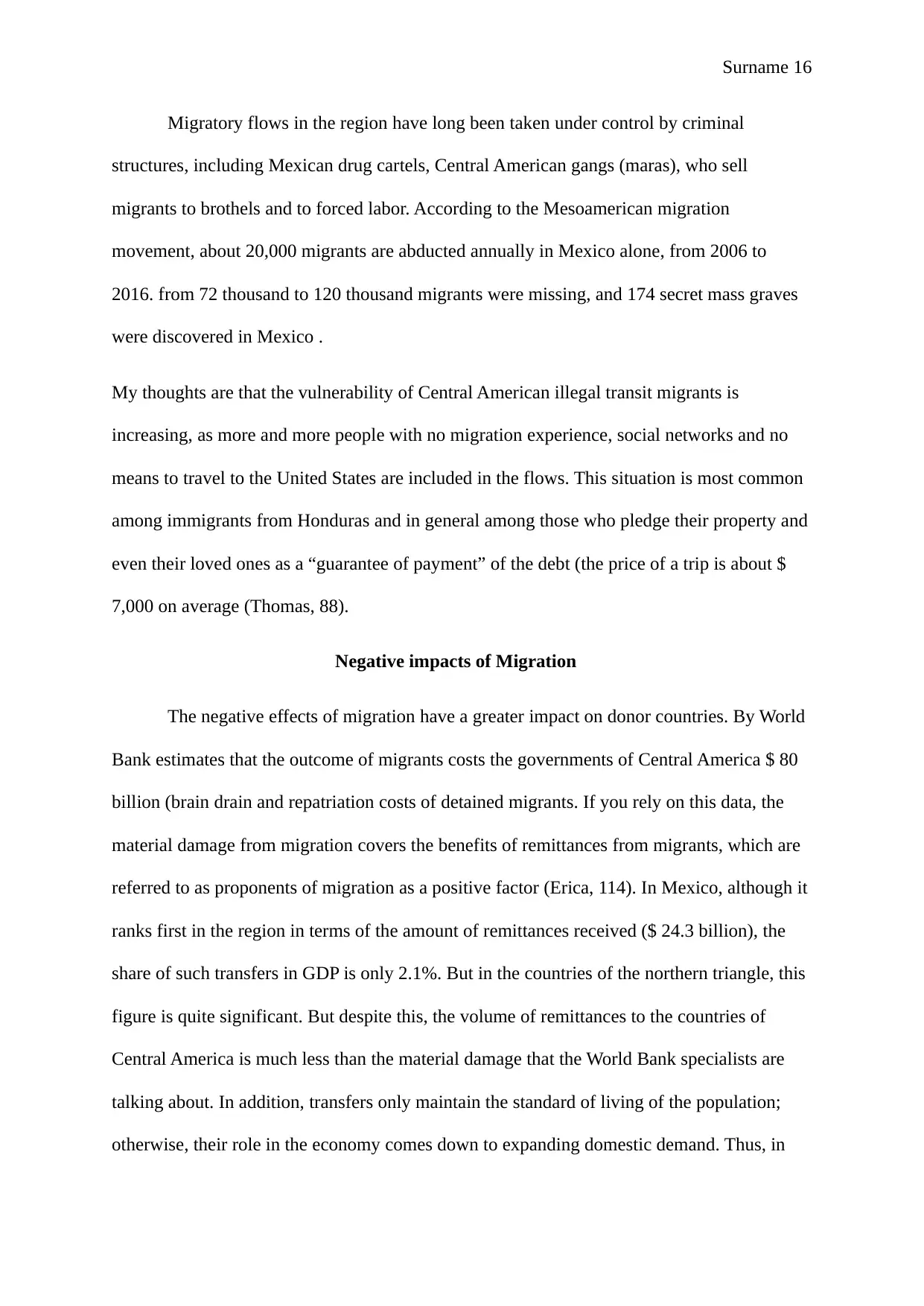
Surname 16
Migratory flows in the region have long been taken under control by criminal
structures, including Mexican drug cartels, Central American gangs (maras), who sell
migrants to brothels and to forced labor. According to the Mesoamerican migration
movement, about 20,000 migrants are abducted annually in Mexico alone, from 2006 to
2016. from 72 thousand to 120 thousand migrants were missing, and 174 secret mass graves
were discovered in Mexico .
My thoughts are that the vulnerability of Central American illegal transit migrants is
increasing, as more and more people with no migration experience, social networks and no
means to travel to the United States are included in the flows. This situation is most common
among immigrants from Honduras and in general among those who pledge their property and
even their loved ones as a “guarantee of payment” of the debt (the price of a trip is about $
7,000 on average (Thomas, 88).
Negative impacts of Migration
The negative effects of migration have a greater impact on donor countries. By World
Bank estimates that the outcome of migrants costs the governments of Central America $ 80
billion (brain drain and repatriation costs of detained migrants. If you rely on this data, the
material damage from migration covers the benefits of remittances from migrants, which are
referred to as proponents of migration as a positive factor (Erica, 114). In Mexico, although it
ranks first in the region in terms of the amount of remittances received ($ 24.3 billion), the
share of such transfers in GDP is only 2.1%. But in the countries of the northern triangle, this
figure is quite significant. But despite this, the volume of remittances to the countries of
Central America is much less than the material damage that the World Bank specialists are
talking about. In addition, transfers only maintain the standard of living of the population;
otherwise, their role in the economy comes down to expanding domestic demand. Thus, in
Migratory flows in the region have long been taken under control by criminal
structures, including Mexican drug cartels, Central American gangs (maras), who sell
migrants to brothels and to forced labor. According to the Mesoamerican migration
movement, about 20,000 migrants are abducted annually in Mexico alone, from 2006 to
2016. from 72 thousand to 120 thousand migrants were missing, and 174 secret mass graves
were discovered in Mexico .
My thoughts are that the vulnerability of Central American illegal transit migrants is
increasing, as more and more people with no migration experience, social networks and no
means to travel to the United States are included in the flows. This situation is most common
among immigrants from Honduras and in general among those who pledge their property and
even their loved ones as a “guarantee of payment” of the debt (the price of a trip is about $
7,000 on average (Thomas, 88).
Negative impacts of Migration
The negative effects of migration have a greater impact on donor countries. By World
Bank estimates that the outcome of migrants costs the governments of Central America $ 80
billion (brain drain and repatriation costs of detained migrants. If you rely on this data, the
material damage from migration covers the benefits of remittances from migrants, which are
referred to as proponents of migration as a positive factor (Erica, 114). In Mexico, although it
ranks first in the region in terms of the amount of remittances received ($ 24.3 billion), the
share of such transfers in GDP is only 2.1%. But in the countries of the northern triangle, this
figure is quite significant. But despite this, the volume of remittances to the countries of
Central America is much less than the material damage that the World Bank specialists are
talking about. In addition, transfers only maintain the standard of living of the population;
otherwise, their role in the economy comes down to expanding domestic demand. Thus, in
Secure Best Marks with AI Grader
Need help grading? Try our AI Grader for instant feedback on your assignments.
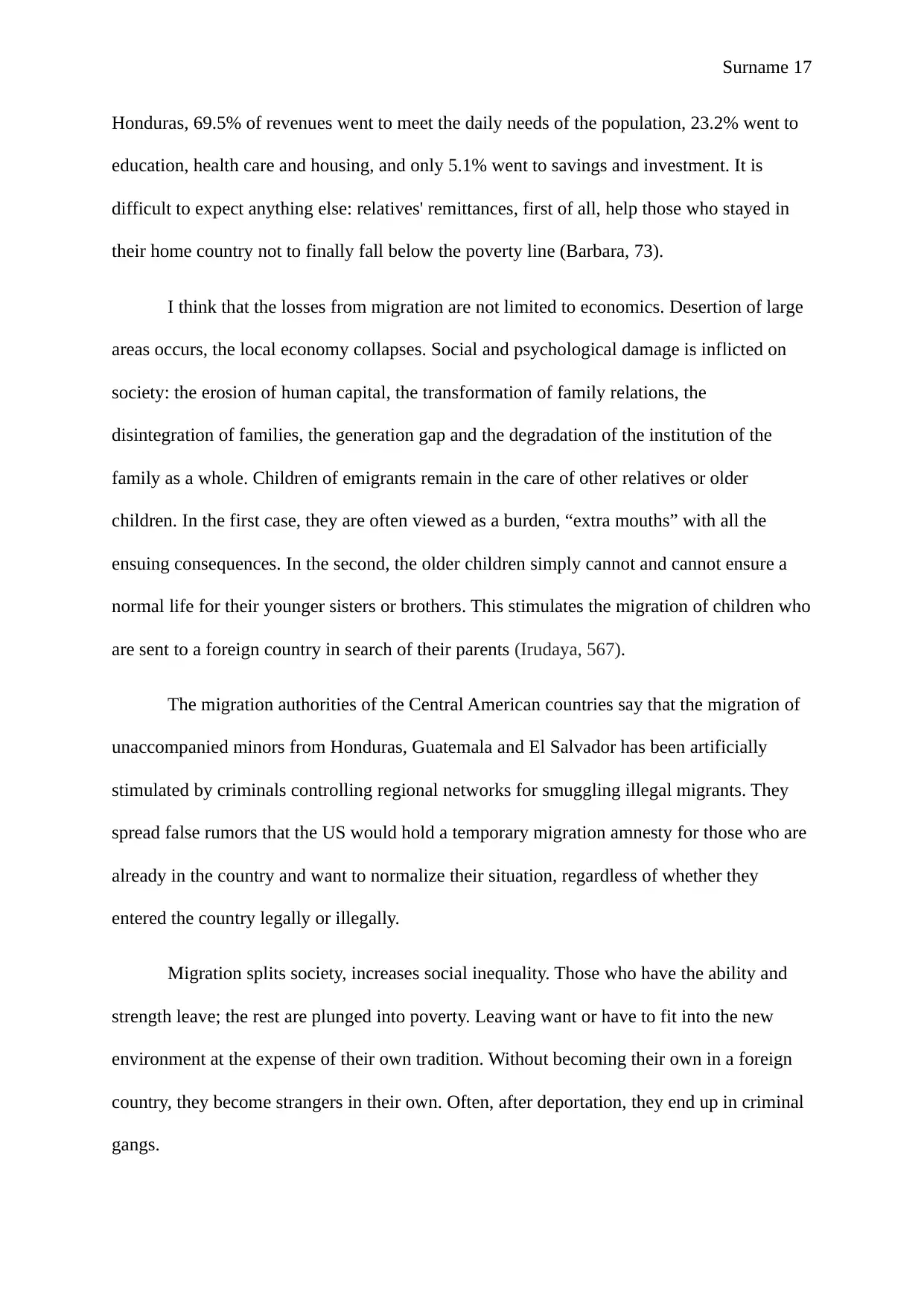
Surname 17
Honduras, 69.5% of revenues went to meet the daily needs of the population, 23.2% went to
education, health care and housing, and only 5.1% went to savings and investment. It is
difficult to expect anything else: relatives' remittances, first of all, help those who stayed in
their home country not to finally fall below the poverty line (Barbara, 73).
I think that the losses from migration are not limited to economics. Desertion of large
areas occurs, the local economy collapses. Social and psychological damage is inflicted on
society: the erosion of human capital, the transformation of family relations, the
disintegration of families, the generation gap and the degradation of the institution of the
family as a whole. Children of emigrants remain in the care of other relatives or older
children. In the first case, they are often viewed as a burden, “extra mouths” with all the
ensuing consequences. In the second, the older children simply cannot and cannot ensure a
normal life for their younger sisters or brothers. This stimulates the migration of children who
are sent to a foreign country in search of their parents (Irudaya, 567).
The migration authorities of the Central American countries say that the migration of
unaccompanied minors from Honduras, Guatemala and El Salvador has been artificially
stimulated by criminals controlling regional networks for smuggling illegal migrants. They
spread false rumors that the US would hold a temporary migration amnesty for those who are
already in the country and want to normalize their situation, regardless of whether they
entered the country legally or illegally.
Migration splits society, increases social inequality. Those who have the ability and
strength leave; the rest are plunged into poverty. Leaving want or have to fit into the new
environment at the expense of their own tradition. Without becoming their own in a foreign
country, they become strangers in their own. Often, after deportation, they end up in criminal
gangs.
Honduras, 69.5% of revenues went to meet the daily needs of the population, 23.2% went to
education, health care and housing, and only 5.1% went to savings and investment. It is
difficult to expect anything else: relatives' remittances, first of all, help those who stayed in
their home country not to finally fall below the poverty line (Barbara, 73).
I think that the losses from migration are not limited to economics. Desertion of large
areas occurs, the local economy collapses. Social and psychological damage is inflicted on
society: the erosion of human capital, the transformation of family relations, the
disintegration of families, the generation gap and the degradation of the institution of the
family as a whole. Children of emigrants remain in the care of other relatives or older
children. In the first case, they are often viewed as a burden, “extra mouths” with all the
ensuing consequences. In the second, the older children simply cannot and cannot ensure a
normal life for their younger sisters or brothers. This stimulates the migration of children who
are sent to a foreign country in search of their parents (Irudaya, 567).
The migration authorities of the Central American countries say that the migration of
unaccompanied minors from Honduras, Guatemala and El Salvador has been artificially
stimulated by criminals controlling regional networks for smuggling illegal migrants. They
spread false rumors that the US would hold a temporary migration amnesty for those who are
already in the country and want to normalize their situation, regardless of whether they
entered the country legally or illegally.
Migration splits society, increases social inequality. Those who have the ability and
strength leave; the rest are plunged into poverty. Leaving want or have to fit into the new
environment at the expense of their own tradition. Without becoming their own in a foreign
country, they become strangers in their own. Often, after deportation, they end up in criminal
gangs.
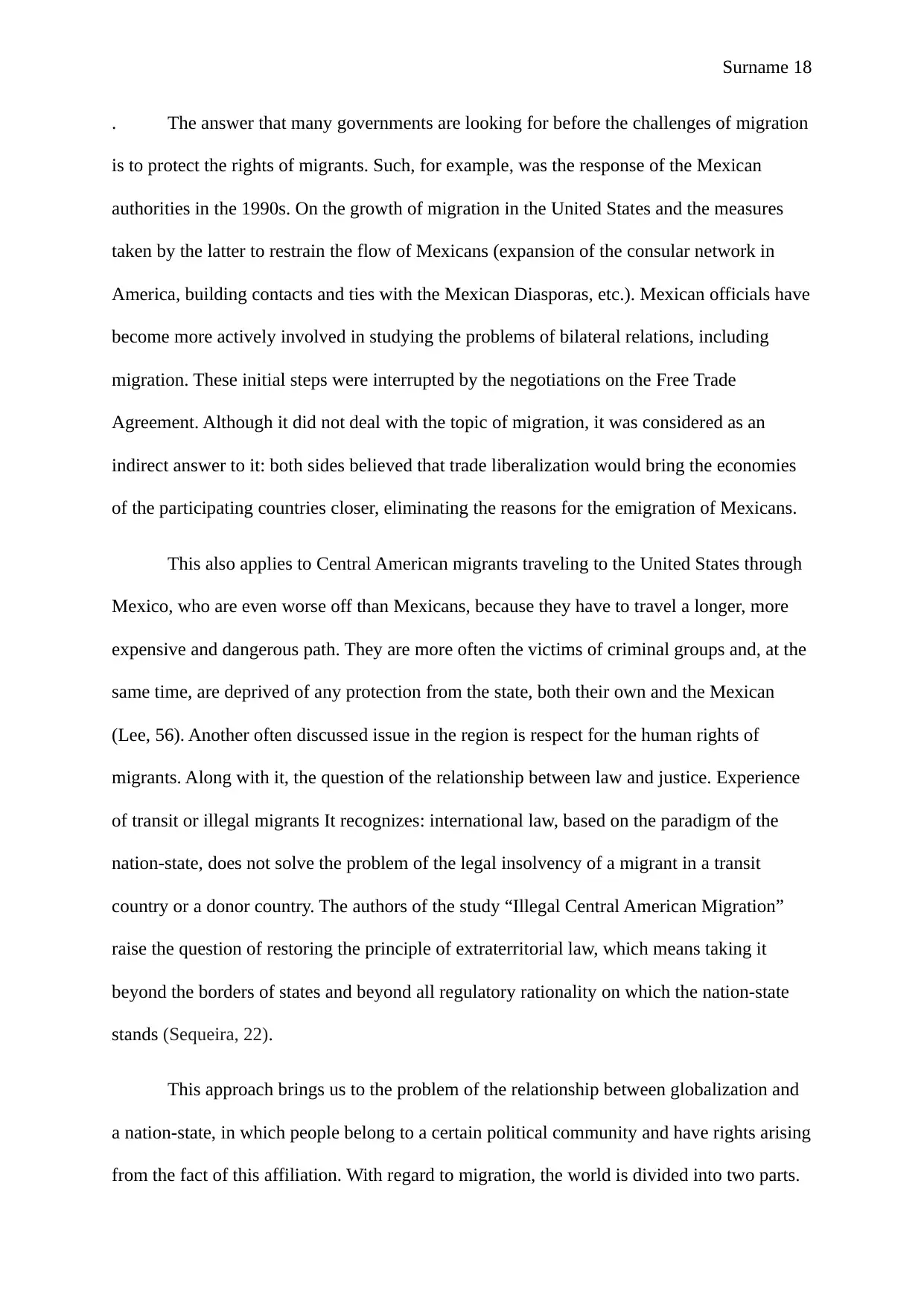
Surname 18
. The answer that many governments are looking for before the challenges of migration
is to protect the rights of migrants. Such, for example, was the response of the Mexican
authorities in the 1990s. On the growth of migration in the United States and the measures
taken by the latter to restrain the flow of Mexicans (expansion of the consular network in
America, building contacts and ties with the Mexican Diasporas, etc.). Mexican officials have
become more actively involved in studying the problems of bilateral relations, including
migration. These initial steps were interrupted by the negotiations on the Free Trade
Agreement. Although it did not deal with the topic of migration, it was considered as an
indirect answer to it: both sides believed that trade liberalization would bring the economies
of the participating countries closer, eliminating the reasons for the emigration of Mexicans.
This also applies to Central American migrants traveling to the United States through
Mexico, who are even worse off than Mexicans, because they have to travel a longer, more
expensive and dangerous path. They are more often the victims of criminal groups and, at the
same time, are deprived of any protection from the state, both their own and the Mexican
(Lee, 56). Another often discussed issue in the region is respect for the human rights of
migrants. Along with it, the question of the relationship between law and justice. Experience
of transit or illegal migrants It recognizes: international law, based on the paradigm of the
nation-state, does not solve the problem of the legal insolvency of a migrant in a transit
country or a donor country. The authors of the study “Illegal Central American Migration”
raise the question of restoring the principle of extraterritorial law, which means taking it
beyond the borders of states and beyond all regulatory rationality on which the nation-state
stands (Sequeira, 22).
This approach brings us to the problem of the relationship between globalization and
a nation-state, in which people belong to a certain political community and have rights arising
from the fact of this affiliation. With regard to migration, the world is divided into two parts.
. The answer that many governments are looking for before the challenges of migration
is to protect the rights of migrants. Such, for example, was the response of the Mexican
authorities in the 1990s. On the growth of migration in the United States and the measures
taken by the latter to restrain the flow of Mexicans (expansion of the consular network in
America, building contacts and ties with the Mexican Diasporas, etc.). Mexican officials have
become more actively involved in studying the problems of bilateral relations, including
migration. These initial steps were interrupted by the negotiations on the Free Trade
Agreement. Although it did not deal with the topic of migration, it was considered as an
indirect answer to it: both sides believed that trade liberalization would bring the economies
of the participating countries closer, eliminating the reasons for the emigration of Mexicans.
This also applies to Central American migrants traveling to the United States through
Mexico, who are even worse off than Mexicans, because they have to travel a longer, more
expensive and dangerous path. They are more often the victims of criminal groups and, at the
same time, are deprived of any protection from the state, both their own and the Mexican
(Lee, 56). Another often discussed issue in the region is respect for the human rights of
migrants. Along with it, the question of the relationship between law and justice. Experience
of transit or illegal migrants It recognizes: international law, based on the paradigm of the
nation-state, does not solve the problem of the legal insolvency of a migrant in a transit
country or a donor country. The authors of the study “Illegal Central American Migration”
raise the question of restoring the principle of extraterritorial law, which means taking it
beyond the borders of states and beyond all regulatory rationality on which the nation-state
stands (Sequeira, 22).
This approach brings us to the problem of the relationship between globalization and
a nation-state, in which people belong to a certain political community and have rights arising
from the fact of this affiliation. With regard to migration, the world is divided into two parts.
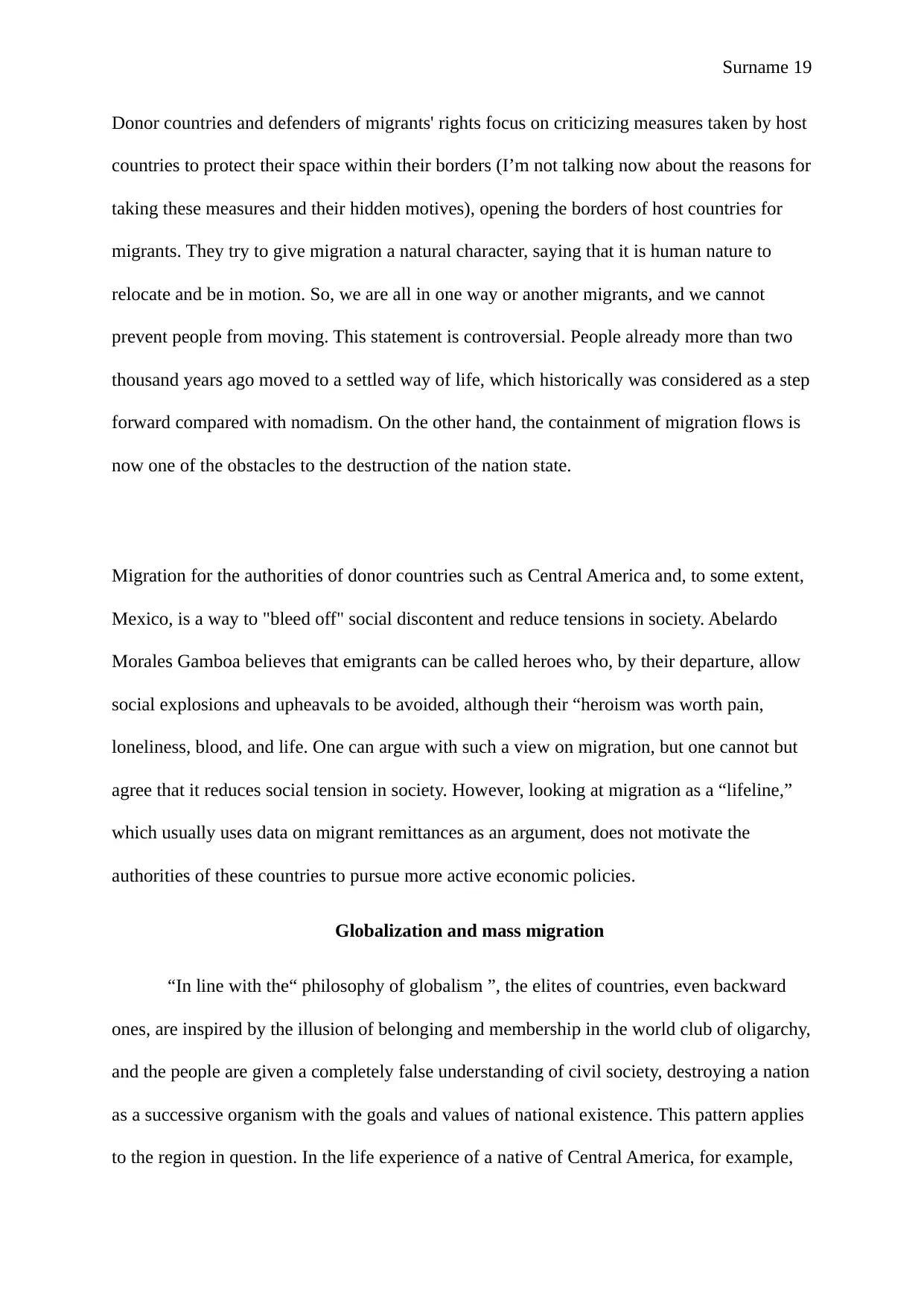
Surname 19
Donor countries and defenders of migrants' rights focus on criticizing measures taken by host
countries to protect their space within their borders (I’m not talking now about the reasons for
taking these measures and their hidden motives), opening the borders of host countries for
migrants. They try to give migration a natural character, saying that it is human nature to
relocate and be in motion. So, we are all in one way or another migrants, and we cannot
prevent people from moving. This statement is controversial. People already more than two
thousand years ago moved to a settled way of life, which historically was considered as a step
forward compared with nomadism. On the other hand, the containment of migration flows is
now one of the obstacles to the destruction of the nation state.
Migration for the authorities of donor countries such as Central America and, to some extent,
Mexico, is a way to "bleed off" social discontent and reduce tensions in society. Abelardo
Morales Gamboa believes that emigrants can be called heroes who, by their departure, allow
social explosions and upheavals to be avoided, although their “heroism was worth pain,
loneliness, blood, and life. One can argue with such a view on migration, but one cannot but
agree that it reduces social tension in society. However, looking at migration as a “lifeline,”
which usually uses data on migrant remittances as an argument, does not motivate the
authorities of these countries to pursue more active economic policies.
Globalization and mass migration
“In line with the“ philosophy of globalism ”, the elites of countries, even backward
ones, are inspired by the illusion of belonging and membership in the world club of oligarchy,
and the people are given a completely false understanding of civil society, destroying a nation
as a successive organism with the goals and values of national existence. This pattern applies
to the region in question. In the life experience of a native of Central America, for example,
Donor countries and defenders of migrants' rights focus on criticizing measures taken by host
countries to protect their space within their borders (I’m not talking now about the reasons for
taking these measures and their hidden motives), opening the borders of host countries for
migrants. They try to give migration a natural character, saying that it is human nature to
relocate and be in motion. So, we are all in one way or another migrants, and we cannot
prevent people from moving. This statement is controversial. People already more than two
thousand years ago moved to a settled way of life, which historically was considered as a step
forward compared with nomadism. On the other hand, the containment of migration flows is
now one of the obstacles to the destruction of the nation state.
Migration for the authorities of donor countries such as Central America and, to some extent,
Mexico, is a way to "bleed off" social discontent and reduce tensions in society. Abelardo
Morales Gamboa believes that emigrants can be called heroes who, by their departure, allow
social explosions and upheavals to be avoided, although their “heroism was worth pain,
loneliness, blood, and life. One can argue with such a view on migration, but one cannot but
agree that it reduces social tension in society. However, looking at migration as a “lifeline,”
which usually uses data on migrant remittances as an argument, does not motivate the
authorities of these countries to pursue more active economic policies.
Globalization and mass migration
“In line with the“ philosophy of globalism ”, the elites of countries, even backward
ones, are inspired by the illusion of belonging and membership in the world club of oligarchy,
and the people are given a completely false understanding of civil society, destroying a nation
as a successive organism with the goals and values of national existence. This pattern applies
to the region in question. In the life experience of a native of Central America, for example,
Paraphrase This Document
Need a fresh take? Get an instant paraphrase of this document with our AI Paraphraser
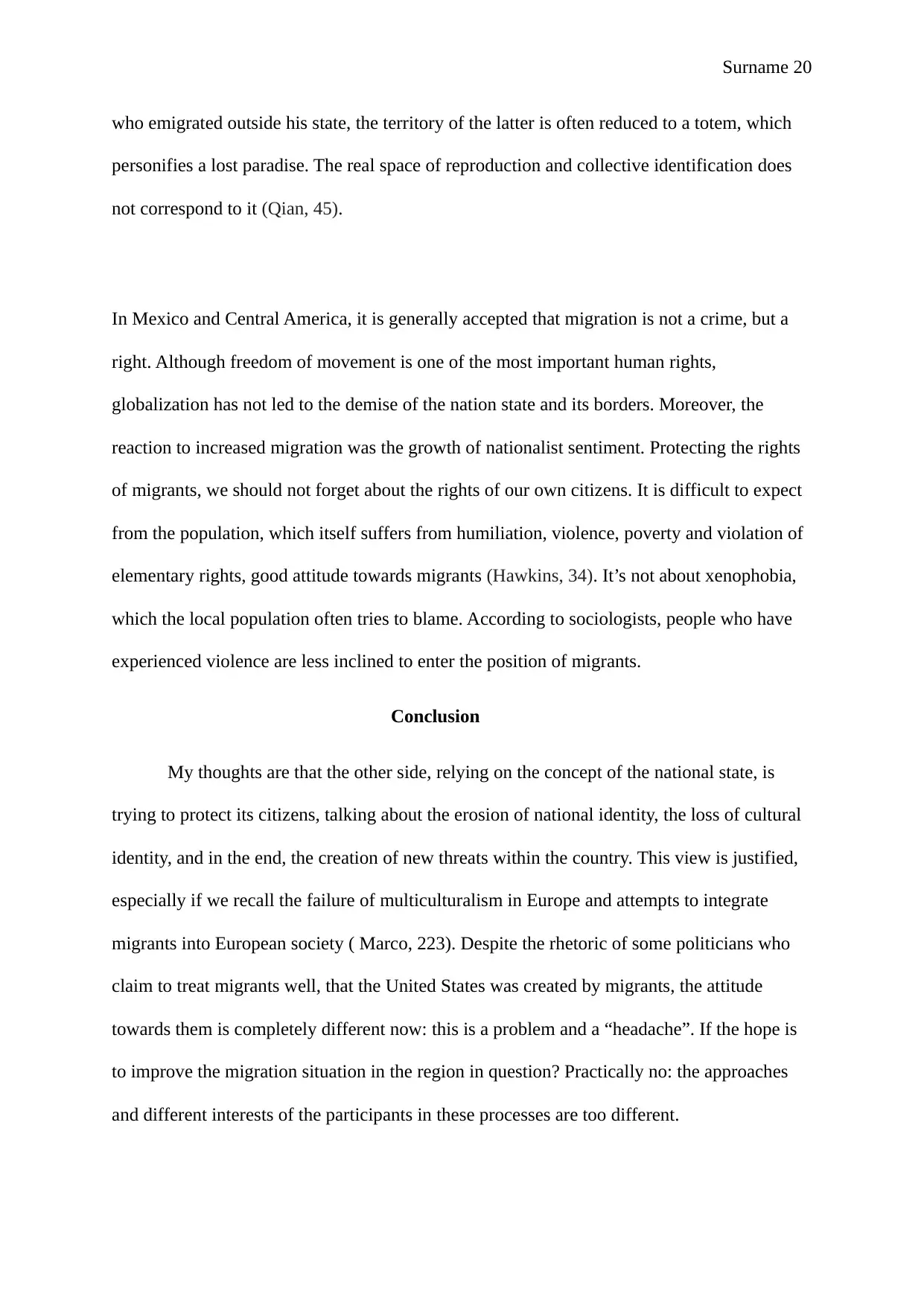
Surname 20
who emigrated outside his state, the territory of the latter is often reduced to a totem, which
personifies a lost paradise. The real space of reproduction and collective identification does
not correspond to it (Qian, 45).
In Mexico and Central America, it is generally accepted that migration is not a crime, but a
right. Although freedom of movement is one of the most important human rights,
globalization has not led to the demise of the nation state and its borders. Moreover, the
reaction to increased migration was the growth of nationalist sentiment. Protecting the rights
of migrants, we should not forget about the rights of our own citizens. It is difficult to expect
from the population, which itself suffers from humiliation, violence, poverty and violation of
elementary rights, good attitude towards migrants (Hawkins, 34). It’s not about xenophobia,
which the local population often tries to blame. According to sociologists, people who have
experienced violence are less inclined to enter the position of migrants.
Conclusion
My thoughts are that the other side, relying on the concept of the national state, is
trying to protect its citizens, talking about the erosion of national identity, the loss of cultural
identity, and in the end, the creation of new threats within the country. This view is justified,
especially if we recall the failure of multiculturalism in Europe and attempts to integrate
migrants into European society ( Marco, 223). Despite the rhetoric of some politicians who
claim to treat migrants well, that the United States was created by migrants, the attitude
towards them is completely different now: this is a problem and a “headache”. If the hope is
to improve the migration situation in the region in question? Practically no: the approaches
and different interests of the participants in these processes are too different.
who emigrated outside his state, the territory of the latter is often reduced to a totem, which
personifies a lost paradise. The real space of reproduction and collective identification does
not correspond to it (Qian, 45).
In Mexico and Central America, it is generally accepted that migration is not a crime, but a
right. Although freedom of movement is one of the most important human rights,
globalization has not led to the demise of the nation state and its borders. Moreover, the
reaction to increased migration was the growth of nationalist sentiment. Protecting the rights
of migrants, we should not forget about the rights of our own citizens. It is difficult to expect
from the population, which itself suffers from humiliation, violence, poverty and violation of
elementary rights, good attitude towards migrants (Hawkins, 34). It’s not about xenophobia,
which the local population often tries to blame. According to sociologists, people who have
experienced violence are less inclined to enter the position of migrants.
Conclusion
My thoughts are that the other side, relying on the concept of the national state, is
trying to protect its citizens, talking about the erosion of national identity, the loss of cultural
identity, and in the end, the creation of new threats within the country. This view is justified,
especially if we recall the failure of multiculturalism in Europe and attempts to integrate
migrants into European society ( Marco, 223). Despite the rhetoric of some politicians who
claim to treat migrants well, that the United States was created by migrants, the attitude
towards them is completely different now: this is a problem and a “headache”. If the hope is
to improve the migration situation in the region in question? Practically no: the approaches
and different interests of the participants in these processes are too different.
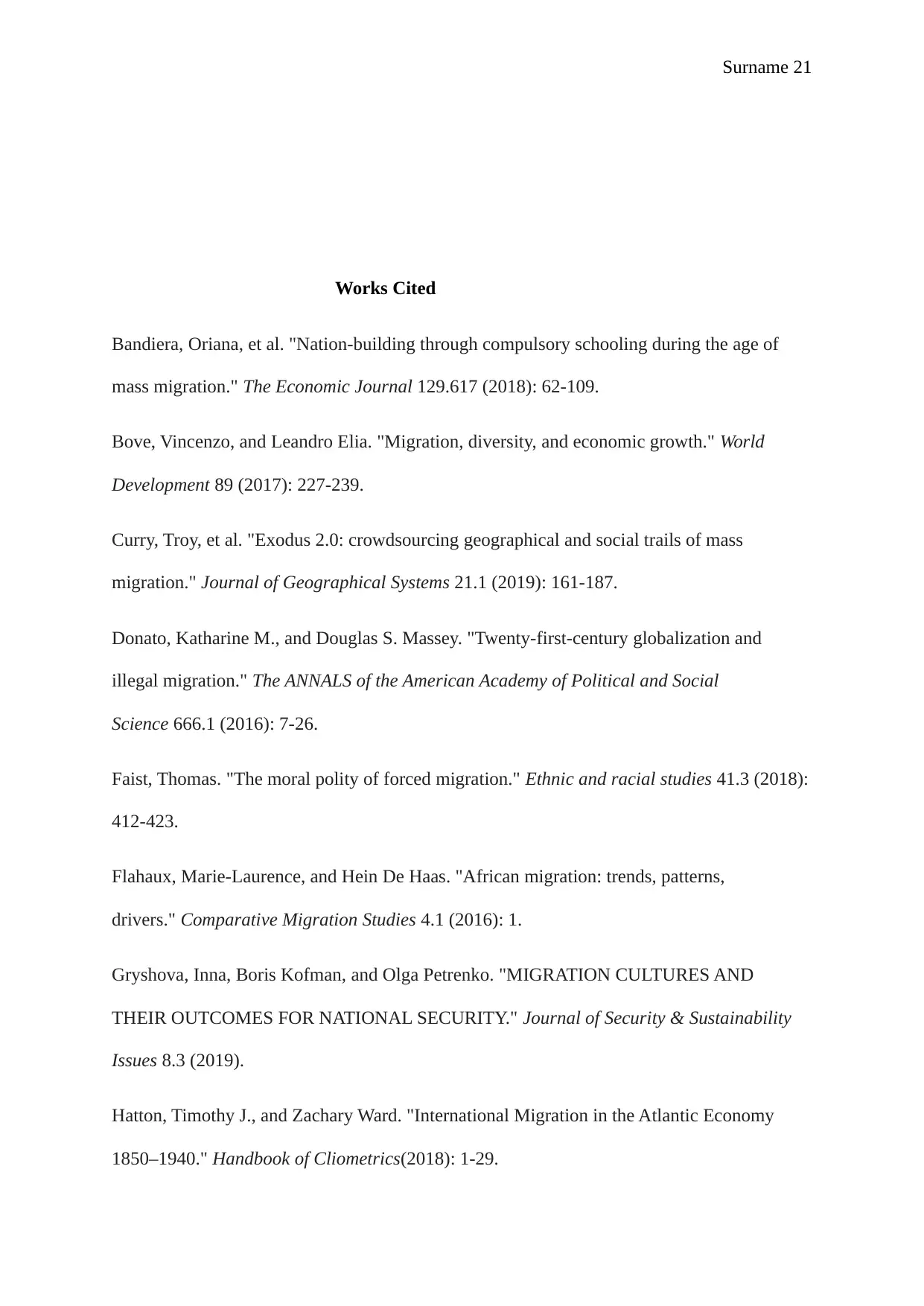
Surname 21
Works Cited
Bandiera, Oriana, et al. "Nation-building through compulsory schooling during the age of
mass migration." The Economic Journal 129.617 (2018): 62-109.
Bove, Vincenzo, and Leandro Elia. "Migration, diversity, and economic growth." World
Development 89 (2017): 227-239.
Curry, Troy, et al. "Exodus 2.0: crowdsourcing geographical and social trails of mass
migration." Journal of Geographical Systems 21.1 (2019): 161-187.
Donato, Katharine M., and Douglas S. Massey. "Twenty-first-century globalization and
illegal migration." The ANNALS of the American Academy of Political and Social
Science 666.1 (2016): 7-26.
Faist, Thomas. "The moral polity of forced migration." Ethnic and racial studies 41.3 (2018):
412-423.
Flahaux, Marie-Laurence, and Hein De Haas. "African migration: trends, patterns,
drivers." Comparative Migration Studies 4.1 (2016): 1.
Gryshova, Inna, Boris Kofman, and Olga Petrenko. "MIGRATION CULTURES AND
THEIR OUTCOMES FOR NATIONAL SECURITY." Journal of Security & Sustainability
Issues 8.3 (2019).
Hatton, Timothy J., and Zachary Ward. "International Migration in the Atlantic Economy
1850–1940." Handbook of Cliometrics(2018): 1-29.
Works Cited
Bandiera, Oriana, et al. "Nation-building through compulsory schooling during the age of
mass migration." The Economic Journal 129.617 (2018): 62-109.
Bove, Vincenzo, and Leandro Elia. "Migration, diversity, and economic growth." World
Development 89 (2017): 227-239.
Curry, Troy, et al. "Exodus 2.0: crowdsourcing geographical and social trails of mass
migration." Journal of Geographical Systems 21.1 (2019): 161-187.
Donato, Katharine M., and Douglas S. Massey. "Twenty-first-century globalization and
illegal migration." The ANNALS of the American Academy of Political and Social
Science 666.1 (2016): 7-26.
Faist, Thomas. "The moral polity of forced migration." Ethnic and racial studies 41.3 (2018):
412-423.
Flahaux, Marie-Laurence, and Hein De Haas. "African migration: trends, patterns,
drivers." Comparative Migration Studies 4.1 (2016): 1.
Gryshova, Inna, Boris Kofman, and Olga Petrenko. "MIGRATION CULTURES AND
THEIR OUTCOMES FOR NATIONAL SECURITY." Journal of Security & Sustainability
Issues 8.3 (2019).
Hatton, Timothy J., and Zachary Ward. "International Migration in the Atlantic Economy
1850–1940." Handbook of Cliometrics(2018): 1-29.

Surname 22
Heather, Peter. "Race, migration and national origins." History, Memory and Public Life.
Routledge, 2018. 90-110.
Larsen, Thomas B. "The making of America’s culture regions." (2019): 1-2.
Lee, Erika. The making of Asian America: A history. Simon and Schuster, 2015.
Lüthi, Barbara. "Migration and Migration History (Version 2.0)." (2018).
Morrison, Andrea, Sergio Petralia, and Dario Diodato. Migration and invention in the age of
mass migration. No. 1835. Utrecht University, Department of Human Geography and Spatial
Planning, Group Economic Geography, 2018.
Nostrand, Richard L. The Making of America's Culture Regions. Rowman & Littlefield,
2018.
Nunn, Nathan, Nancy Qian, and Sandra Sequeira. "Migrants and the making of america: The
short and long run effects of immigration during the age of mass migration." (2017).
Qian, W. A. N. G. "Seize the Trend of Population Migration and Improve Health and Family
Planning Services for Migrant Population." China Population Today 6 (2016): 2.
Rajan, S. Irudaya. "Politics of conflict and migration." India Migrations Reader. Routledge
India, 2016. 151-157.
Rodríguez‐Pose, Andrés, and Viola von Berlepsch. "European Migration, National Origin and
Long‐term Economic Development in the United States." Economic Geography 91.4 (2015):
393-424.
Schiffels, Stephan, et al. "Iron age and Anglo-Saxon genomes from East England reveal
British migration history." Nature communications 7 (2016): 10408.
Heather, Peter. "Race, migration and national origins." History, Memory and Public Life.
Routledge, 2018. 90-110.
Larsen, Thomas B. "The making of America’s culture regions." (2019): 1-2.
Lee, Erika. The making of Asian America: A history. Simon and Schuster, 2015.
Lüthi, Barbara. "Migration and Migration History (Version 2.0)." (2018).
Morrison, Andrea, Sergio Petralia, and Dario Diodato. Migration and invention in the age of
mass migration. No. 1835. Utrecht University, Department of Human Geography and Spatial
Planning, Group Economic Geography, 2018.
Nostrand, Richard L. The Making of America's Culture Regions. Rowman & Littlefield,
2018.
Nunn, Nathan, Nancy Qian, and Sandra Sequeira. "Migrants and the making of america: The
short and long run effects of immigration during the age of mass migration." (2017).
Qian, W. A. N. G. "Seize the Trend of Population Migration and Improve Health and Family
Planning Services for Migrant Population." China Population Today 6 (2016): 2.
Rajan, S. Irudaya. "Politics of conflict and migration." India Migrations Reader. Routledge
India, 2016. 151-157.
Rodríguez‐Pose, Andrés, and Viola von Berlepsch. "European Migration, National Origin and
Long‐term Economic Development in the United States." Economic Geography 91.4 (2015):
393-424.
Schiffels, Stephan, et al. "Iron age and Anglo-Saxon genomes from East England reveal
British migration history." Nature communications 7 (2016): 10408.
Secure Best Marks with AI Grader
Need help grading? Try our AI Grader for instant feedback on your assignments.
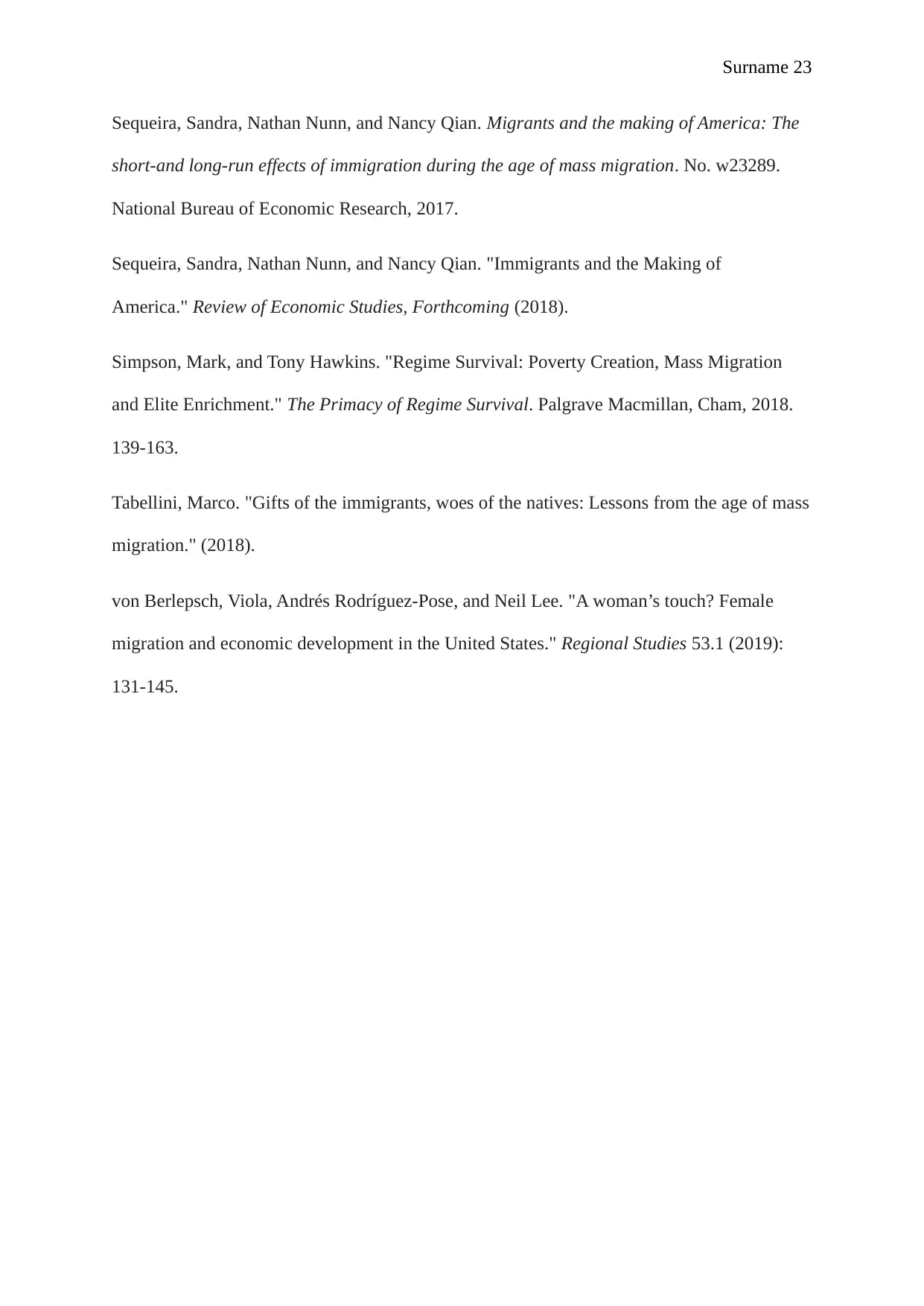
Surname 23
Sequeira, Sandra, Nathan Nunn, and Nancy Qian. Migrants and the making of America: The
short-and long-run effects of immigration during the age of mass migration. No. w23289.
National Bureau of Economic Research, 2017.
Sequeira, Sandra, Nathan Nunn, and Nancy Qian. "Immigrants and the Making of
America." Review of Economic Studies, Forthcoming (2018).
Simpson, Mark, and Tony Hawkins. "Regime Survival: Poverty Creation, Mass Migration
and Elite Enrichment." The Primacy of Regime Survival. Palgrave Macmillan, Cham, 2018.
139-163.
Tabellini, Marco. "Gifts of the immigrants, woes of the natives: Lessons from the age of mass
migration." (2018).
von Berlepsch, Viola, Andrés Rodríguez-Pose, and Neil Lee. "A woman’s touch? Female
migration and economic development in the United States." Regional Studies 53.1 (2019):
131-145.
Sequeira, Sandra, Nathan Nunn, and Nancy Qian. Migrants and the making of America: The
short-and long-run effects of immigration during the age of mass migration. No. w23289.
National Bureau of Economic Research, 2017.
Sequeira, Sandra, Nathan Nunn, and Nancy Qian. "Immigrants and the Making of
America." Review of Economic Studies, Forthcoming (2018).
Simpson, Mark, and Tony Hawkins. "Regime Survival: Poverty Creation, Mass Migration
and Elite Enrichment." The Primacy of Regime Survival. Palgrave Macmillan, Cham, 2018.
139-163.
Tabellini, Marco. "Gifts of the immigrants, woes of the natives: Lessons from the age of mass
migration." (2018).
von Berlepsch, Viola, Andrés Rodríguez-Pose, and Neil Lee. "A woman’s touch? Female
migration and economic development in the United States." Regional Studies 53.1 (2019):
131-145.
1 out of 23
Your All-in-One AI-Powered Toolkit for Academic Success.
+13062052269
info@desklib.com
Available 24*7 on WhatsApp / Email
![[object Object]](/_next/static/media/star-bottom.7253800d.svg)
Unlock your academic potential
© 2024 | Zucol Services PVT LTD | All rights reserved.
